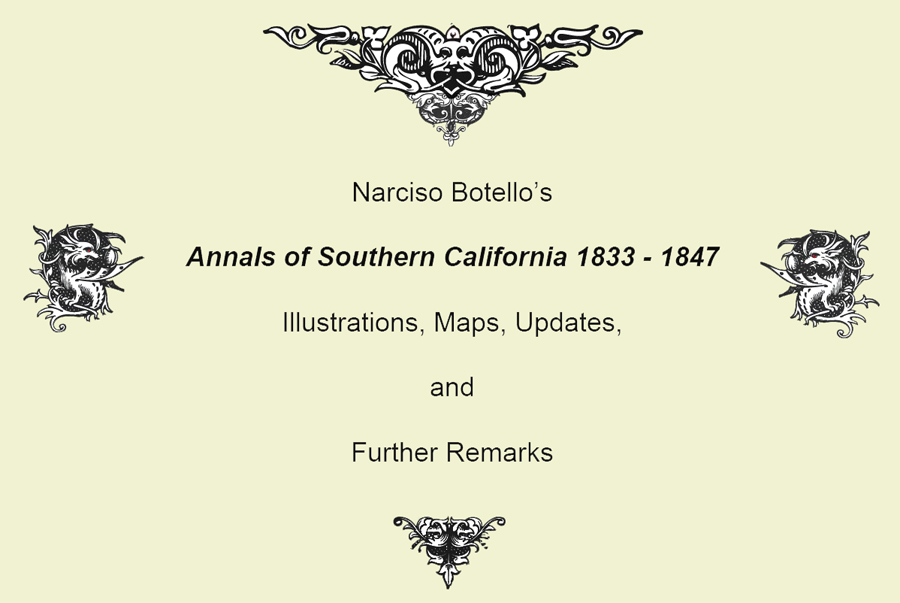

Copyright © Brent C.
Dickerson
I would like to warmly thank California State University, Long Beach, for generously hosting this site dedicated to fostering an understanding of the people, conditions, and ethos of an earlier period of our area. These materials, to be developed, elaborated, edited, and updated continuously, are provided to enrich peoples' understanding of a short period of pre-Yankee California, and deepen the understanding and broaden the background for readers of my book Narciso Botello's Annals of Southern California 1833–1847, as well as to supply corrections or "fine-tuning" arising from further research. All materials on this site respect copyright law and the doctrine of fair use; should anyone know anything to the contrary concerning a specific item, please have the person in possession of the rights on the particular item or items contact me at once so I can remove the material in question. The drawings, and details of drawings, by William Rich Hutton which appear on this site are here by very special and specific courtesy of the Huntington Library, San Marino, California; requests concerning any further use of these images by Hutton must be made to not me but rather the Huntington Library. While other images on this site have in many cases had enhancements or changes of one sort or another for æsthetic or historical reasons (in other words, to "fix" blemishes, or to alter the view to something more specific to what Botello would have seen), these images of Hutton's are presented as drawn, in their current state, with at most a few pixels cropped around the perimeters to provide a smooth-looking edge to the images. Those wishing to contribute corrections or other matter relating to Botello's text and the California or Mexico of its time are not only welcome to contact me—they are encouraged to do so via e-mail at odinthor@csulb.edu. Please include the source of the data supplied, and, if applicable, if it is under copyright. Contributors should indicate in their messages whether they wish their names to be included should the material be published on this site. Materials provided will be regarded as being supplied voluntarily and gratis, with no anticipation of monetary compensation. Current representatives of the families which take part in Botello's narrative, or those which were present during the time of his narrative, are also encouraged to contact me with pertinent information, including family stories, about their ancestors and their ancestors' doings. As in the book itself, notes are referenced by the number of the paragraph in Botello's text in which the item in question occurs. Many thanks to Franklin G. Mead, descendant of the old Angeleno families Cota (Maria Luisa Cota) and Rosas (Jose Antonio Basilio Rosas), for his great help in catching many of these typographical errors!
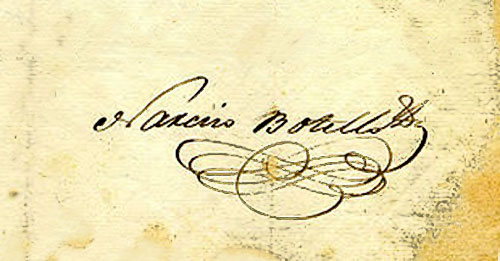
• This section refers to Botello's text:
¶ 1.
–A map of a portion of Baja
California and Sonora, showing the area of Botello's initial
travels (developed from an original map in Bancroft's History of
California).
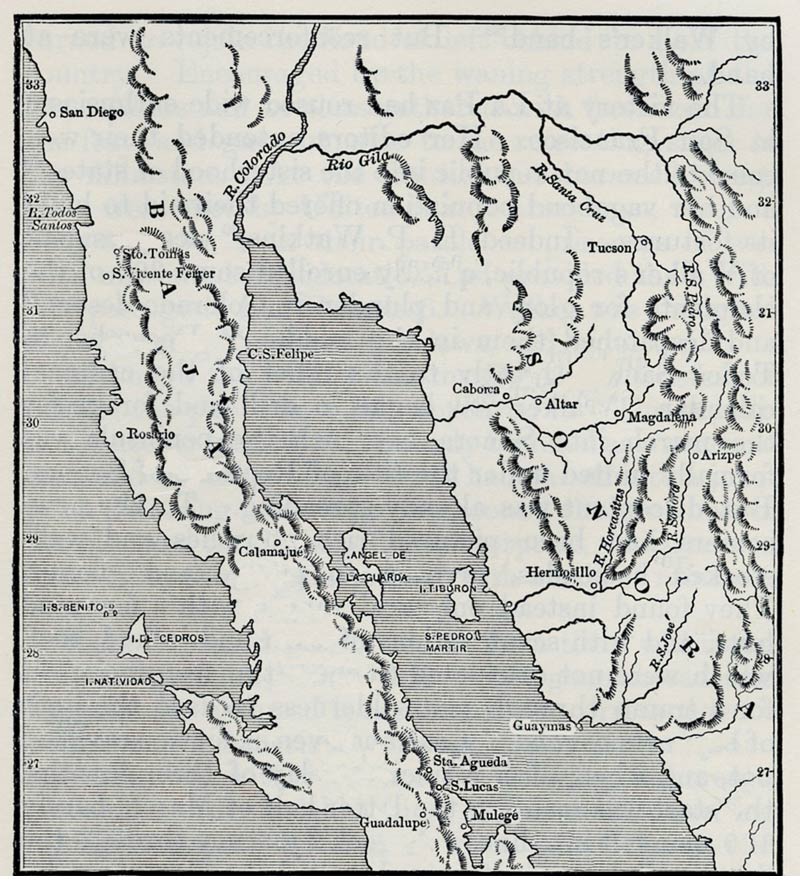
–The pleasures of overland travel in 1830s Mexico. Plate by Carl Nebel entitled Arrieros, from Voyage Pittoresque... of 1836.

¶ 2.
–Guaymas:
Some description of Guaymas from the mid- to late-1820s, when it would
have been familiar to Botello, this from R.W.H. Hardy's Travel in the
Interior of Mexico, pp. 89-91. "We arrived at the port of Guaymas on
the 8th February. The harbour is, beyond all question, the best in the
Mexican dominions: it is surrounded by land on all sides, and protected
from the winds by high hills. It is not very extensive, nor is the water
above five fathoms deep abreast of the pier; but there are deeper
soundings farther off. It would shelter a large number of vessels. The
entrance is defended by the island of Paxaros [sic], on which, at
the proper season of the year, is found a prodigious quantity of eggs,
deposited by gulls, so that its surface becomes completely whitened by the
vestiges which they leave behind them. During the dry season, the hills
which surround the harbour present a sterile appearance, truly unpleasing
to the eye, and give but a bad idea of the prosperity of the town; while
the size of the houses, the number of its inhabitants, or the want of
cattle in its neighbourhood, do not tend to remove that impression. [...]
The founder of Guaymas is still an inhabitant of it; an old man, who is
seldom sober when he can get tipsy. He sometimes buys a barrel of liquor
to retail to the sailors of vessels who frequent the port. But, as he
says, he always likes to keep the tap running; so when there are no other
customers, he becomes one himself. [...] Guaymas is a miserable place,
that is, as far as regards the houses, covered with mould, so that, during
a hard rain, the inmates may take a shower-bath without going out of
doors. The rafters are whole palm-trees; and there is a large kind of
humble-bee which perforates them with the greatest ease, so that, by
degrees, these great bores, which serve the insect for a nest, so
weaken the rafters, that the lodger may sometimes find a grave without
going to the churchyard, the roof falling for want of due support; which
has since happened to the very house wherein we then resided."
–A look at Guaymas from its harbor, under attack by the Yankees in 1847 in the Mexican-American War. Drawing by Gunner William H. Meyers, who indeed depicts himself, the rearmost figure in the darkest hat attending the gun at center. Acquired with others of Meyers' sketches by Franklin Delano Roosevelt, and published in the rare 1939 book Naval Sketches of the War in California, a copy of which I happily own. The book has many images of interest to students of California history, and of the history of the Mexican-American War; but I limit myself to using on this site only three of Meyers' sketches in full, plus one detail from another. Here, we see the "sterile appearance" of the hills mentioned above by Hardy.

¶ 3.
–Richard
York: Richard York's correct name appears to be Richard
Yeoward. Yeoward was an agent of the British firm of William Duff & Co.
The ship co-owned by Yeoward (probably representing his employers Duff &
Co.) and Requena was the
Margarita.
–Commissioner-General
Riesgo: Juan Miguel Riesgo was the first governor of the
Estado de Occidente, the combination Mexican state which
comprised the former states of Sinaloa and Sonora, which were to be
separated again in 1830. I can offer a little more on Riesgo from the
same source quoted previously, R.W.H. Hardy's Travels in the Interior
of Mexico, p. 74ff: "The first person to whom I paid my respects on
my arrival here [Rosario], was Don Miguel Riesgo,
Commissary-general of the united provinces of Sonora and Sinaloa. [...]
I found him occupied in dictating dispatches to four clerks at the same
time, which he appeared to do with the greatest facility, even while
holding a conversation with me upon indifferent subjects. Whether he
owed this facility to memory or talent, it is difficult to determine, as
both these qualities may exist separately [...]. However, as he is the
most remarkable person in Rosario, I shall endeavour to give a
full-length portrait of him, observing only, that he sat to me but a few
times. Riesgo is a man whose jesuitically straight-combed hair and hard
features are considered, by those who know him best, to betray the
peculiar characteristics of his mind, The perpendicular furrows on his
face showed that the softening influence of a smile was a stranger
there, or, at least, that the experience was 'like Angels' visits, few,
and far between,' strongly indicating his habitual thoughtfulness and
cold calculation. The expression of his prominent eye showed quickness
of penetration, and, to a close observer, unsubdued irritability, and a
certain sinister and sycophantic disposition, which gave to his tout
ensemble the air of a courtier, joined to the sternness and pride of
a Republican in office. His firm tread was that of a man who knew that
his authority gave him importance, and had placed him in a situation to
make even his smallest wish obeyed by his inferiors. His whole carriage
indicated that he was neither ignorant of the great advantages of
possessing talents and education, nor careful to disguise the
supercilious contempt which he entertained for the greater part of those
by whom he was usually surrounded. Yet, with all the consciousness of
his own importance and mental superiority, there was a lurking
expression about Riesgo's mouth, which indicated the absence of entire
tranquillity, and gave rise to the suspicion of some hidden weakness in
his composition. [...] Certain it is, that although absent from his wife
and family, he was not condemned to forego the pleasures of female
society. But ever-waking scandal, we well know, seeks to fix upon the
noblest and most exalted, in order to level them with the common
standard of mankind; and may, therefore, have wantonly inflicted an
undeserved wound in the character of Don Miguel Riesgo. Whether or not
he sustained unmerited injury from such reports, he certainly suffered
much in the cause of the Revolution. At his own table we found him
hospitable, and exceedingly entertaining in his conversation, which
teemed with anecdote and severe satire, in the indiscriminate use of
which last he was by no means sparing, either to friend or foe. [...] In
his youth he had, I believe, been educated by the Jesuits, and, as I
understood, written a pamphlet in their justification. I would fain
attempt to relate some of his very curious stories; but it would be
impossible to retain the same spirit, and, above all, the same quaint
mode of expression." One can see why Requena could have felt
uncomfortable with Riesgo. Riesgo was born in Horcasitas; his
governorship of the Estado de Occidente lasted from September 12
to October 7, 1824; he died August 8, 1834.
¶ 5.
–The ship arrived at San
Pedro: Below, William Rich Hutton's depiction of the lonely
shore at San Pedro. One of the two structures shown is a warehouse/hide
house owned by Abel Stearns. (Image courtesy the Huntington Library, San
Marino, California. Call number HM 43214 (24). Used by permission.)
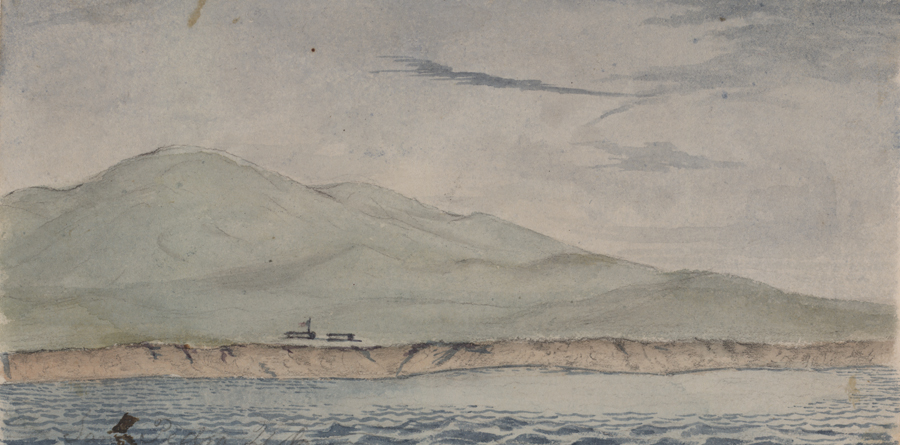
¶ 6.
–due to our taking the
wrong trail: "Roads in many parts of Mexico, and particularly
in the interior provinces, are merely paths traversed by horses and mules,
but never by a coach or waggon [sic]. And it requires a great
knowledge of travelling, constant observation, and nice discernment, to
make out the tracks which distinguish a high road from one which merely
leads to the open country, frequented only by those who go for wood; or
even from a rabbit track, as they all resemble each other as much as the
two blades of a pair of scissors" (from Hardy's Travels in the Interior
of Mexico, p. 224).
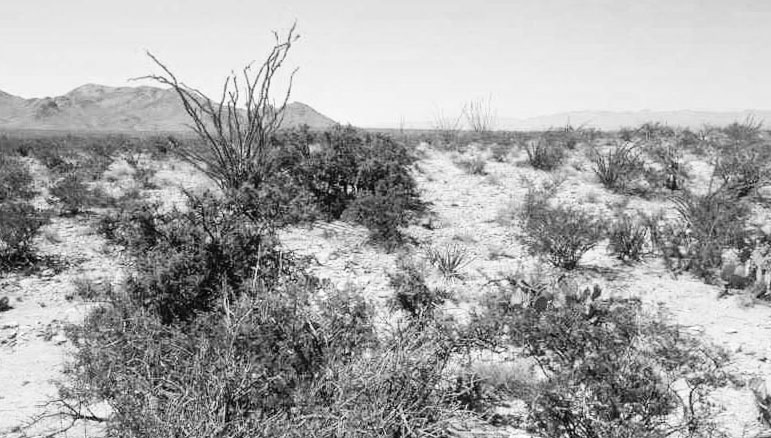
–arrived in Los Angeles towards the end of April: Ah, what is this unremarkable vale which strikes our eyes? Why, 'tis the site of L.A. in all its primitivity before undergoing the tender mercies of the human race. Observing from the east, well before Botello's time, we see where Los Angeles would be. The Los Angeles River, arriving from the San Fernando Valley at right, flows, if it flows at all, left towards the distant ocean. Careful observation at center will reveal what was to become La Loma de las Mariposas–Fort Hill–as well as the great Aliso tree which gave Aliso St. its name, and which was the focal point of the rancheria of Yang-Na, all the inhabitants of which appear to be away on a visit somewhere. The future Pound Cake Hill is visible, faintly, as is the range of hills someday to be known collectively as Bunker Hill; and Arroyo Seco is below us to our right. This view will impart a sense of the lie of the land for our proceedings.
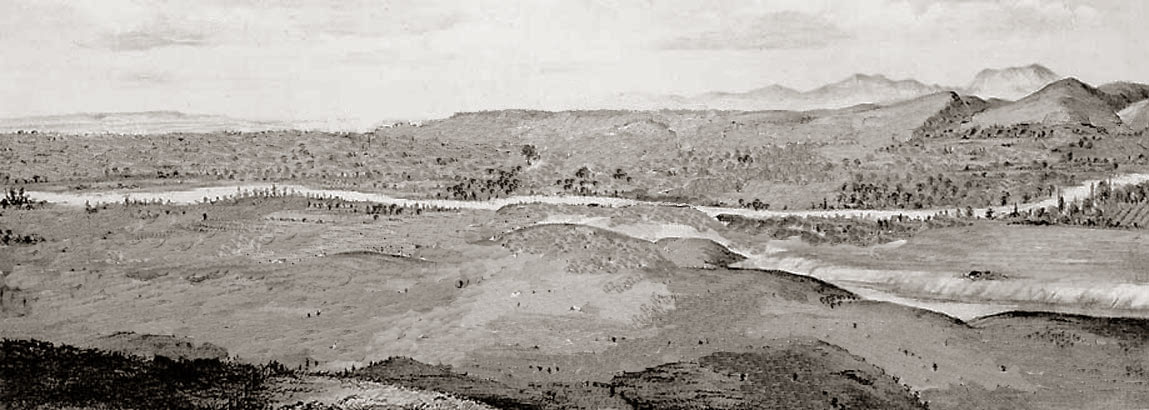
–Los Angeles: Botello and Johnson likely arrived in L.A. via one of two roads, amounting to either north or south of the Mesa. South of the Mesa would have brought them in on what came to be known as Aliso Street. From somewhat south of Aliso Street–to wit, from the roof of Nathaniel Pryor's adobe–William Rich Hutton gives us an idea of how something like this approach would have appeared in 1847, the main difference from the early 1830s being of course the presence of Fort Moore above the pueblo. At center as we approach, prominent is the two-story Bell Block. On the hillside below Fort Moore is the pueblo's old calaboose. (Image courtesy the Huntington Library, San Marino, California, call number HM 43214 (25), used by permission.)
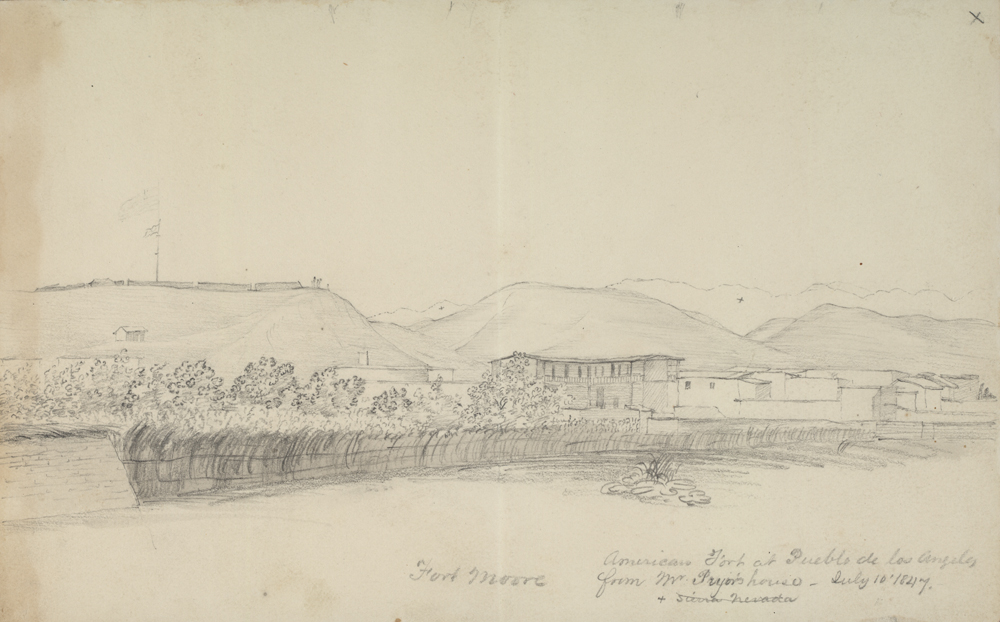
–But we must also see the Pueblo as we approach from the south. William Rich Hutton provides a drawing which I must admit baffles me in several ways; but we seem to be standing at about what would become 1st Street, a bit west of Spring Street, looking north. Hutton appears to have taken some liberties in this sketch, and perhaps we should take it as more of an "impression" than as a depiction. In particular, he seems to have suppressed any buildings south of what would now be Temple Street. This was likely a preliminary sketch for a more familiar color picture by Hutton, one which takes even more liberties but which compensates by featuring as amiable a horse as you could hope to see. (Image courtesy the Huntington Library, San Marino, California, call number HM 43214 (28); used by permission.)
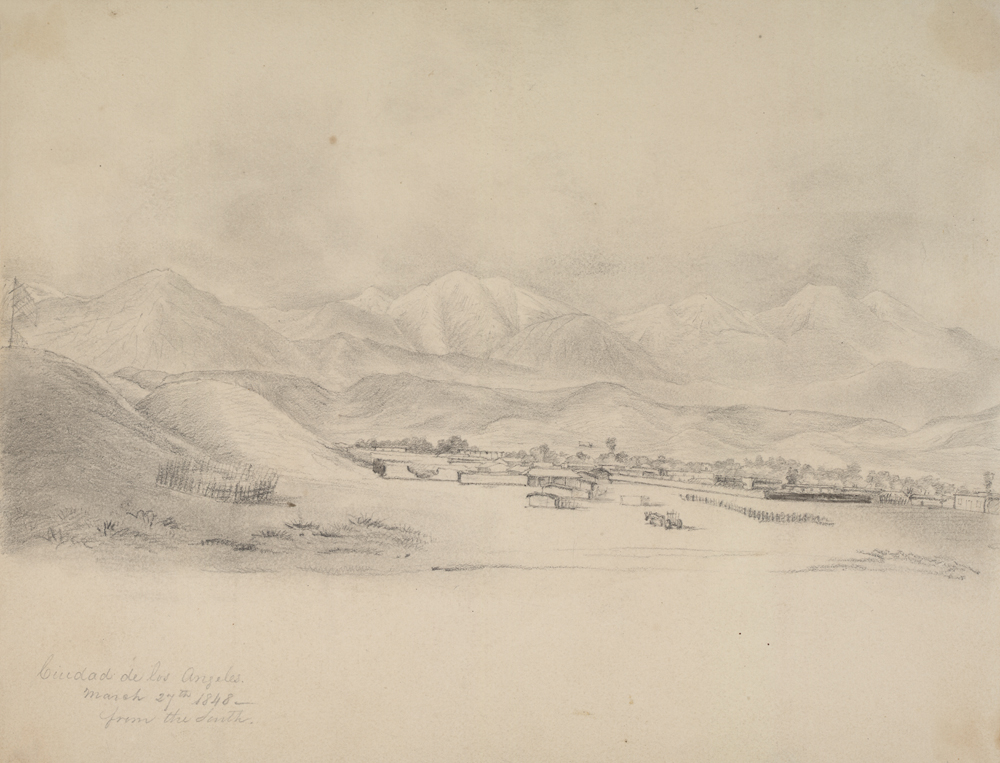
–Hutton also shares a very high view from the north, as L.A. appeared in 1852. (Image courtesy the Huntington Library, San Marino, California, call number HM 43214 (32); used by permission.)
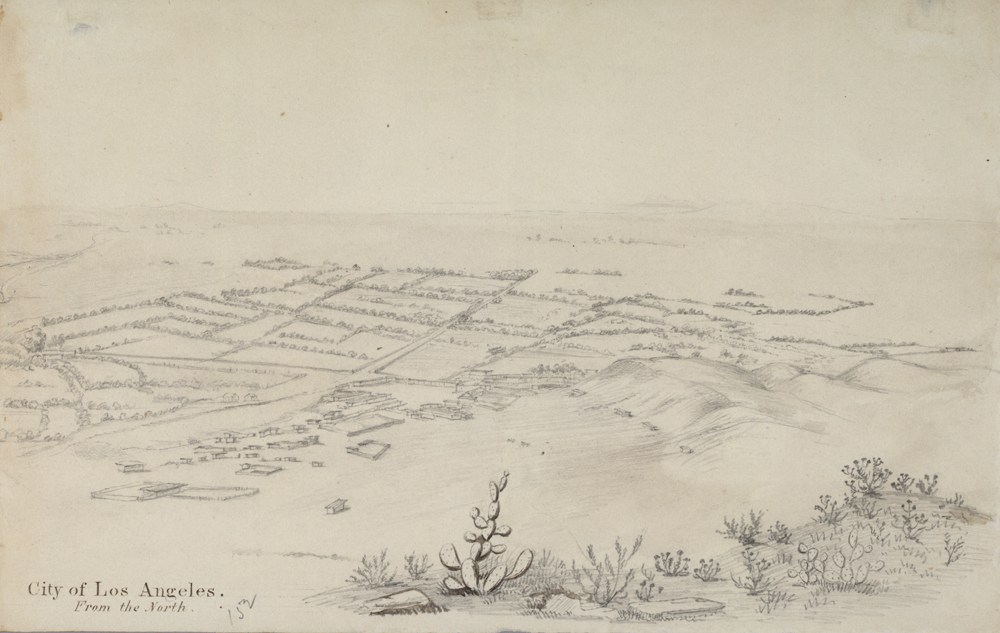
–Below, a much-enlarged detail from the above of the Plaza area in 1852. The Bell Block (near the upper right corner) and the Church (at the upper right corner of the Plaza) are easy to pick out. The Avila Adobe on what later would be Olvera Street is the building which edges closest to center left margin. Alameda Street exits the detail, going towards the south, at top center. (Permission from the Huntington Library as above.) The original Plaza, which evidently was still clear in Botello's first years in L.A. (1833-1834) now is the site of the several structures we see close to us at lower right.
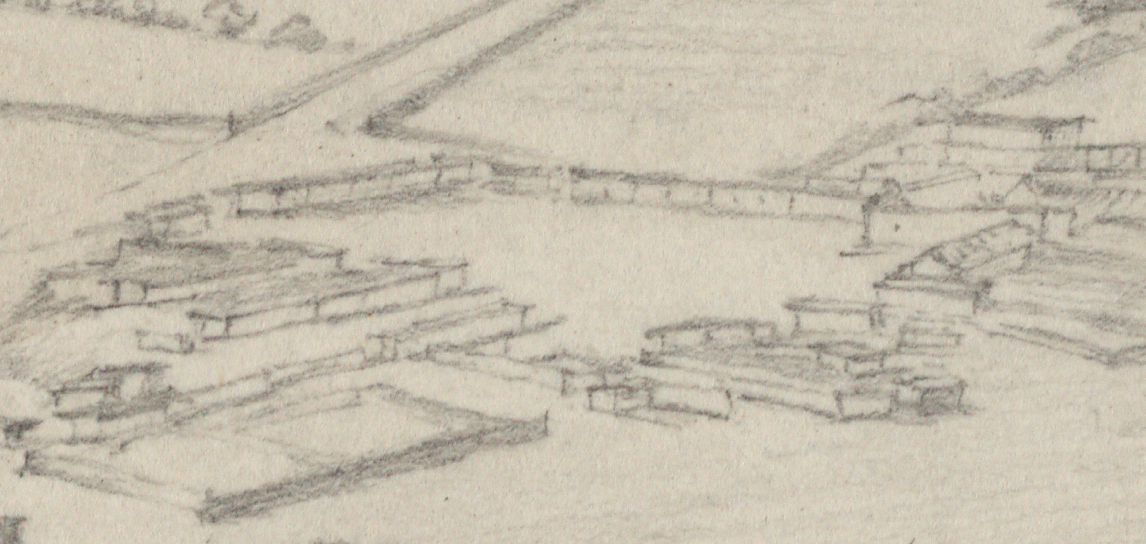
–South, east, north–now we need a look from the west, again courtesy of Hutton, who gives us in this and the next view probably the definitive views of our pueblo in the pre-Yankee era. Below us, at center, is the rear of the Plaza Church, the much-used rectory–so often a part of our story–is off to the left of the Church, with its own yard/corral. To the left of that, extending to the left edge of the picture, is the site of the original Plaza, still partially clear. The Plaza corner of what would become Olvera Street is beyond the top of the Church's facade, with Olvera Street extending to the left; on it, we get a good view of the front of the Avila adobe. Across the Plaza, opposite the church, we see the Lugo adobe, not yet a two-story structure. In front of us, next to the Church, is a yard which might or might not be a cemetery; to the right of that is the Mariano Dominguez adobe. (Image courtesy the Huntington Library, San Marino, California, call number HM 43214 (29). Used by permission.)
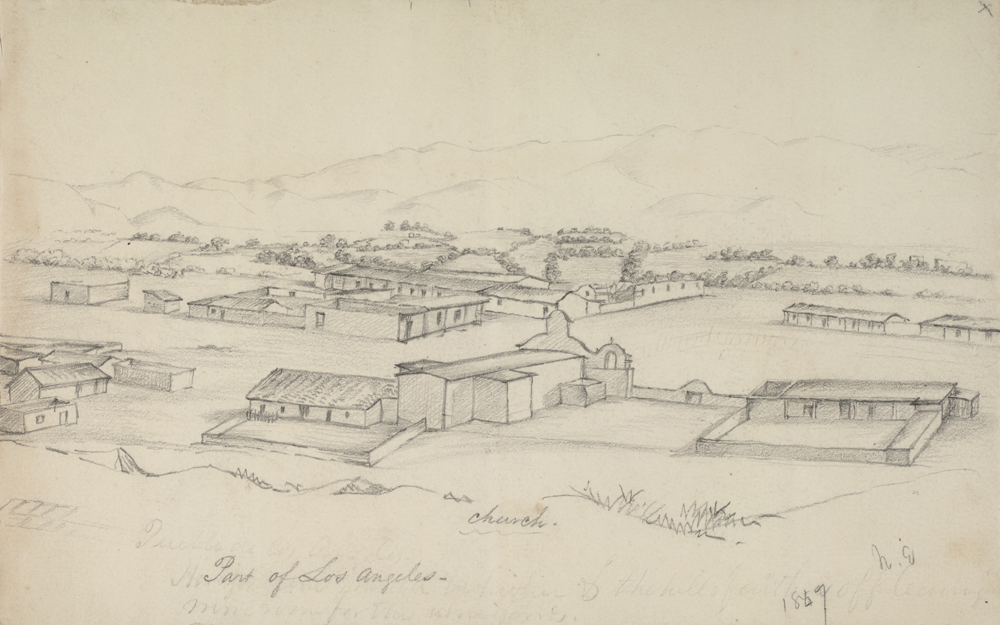
–For unknown reasons, Hutton skipped over the interesting area from the south perimeter of the Plaza to Aliso Street, depriving us of a view of the Jose Antonio Ezequiel Carrillo home, the two-story Vicente Sanchez home, the back of the Coronel adobe, and the other features of that area. But, in the view below, we can see from the west what we saw, a few images above, from the east: the two-story Bell Block at what would be the corner of Aliso Street with Los Angeles Street, and, beyond it, the Nathaniel Pryor adobe, from the roof of which Hutton drew the earlier image. On the nearer side of the Bell Block is El Palacio, the Abel Stearns residence, which features so prominently in L.A. history; we shall get a look at Don Abel himself in a moment. Going to the right, along Main Street, passing one lot of a jumble of small structures, we come to the Isaac Williams adobe with its large corral in back. The Williams adobe would be used for governmental purposes for a time, in both the Mexican and Yankee eras (it was the court house for the famous Lugo case), before becoming the original Bella Union Hotel. To the right of the Williams adobe, and, like it, partially obscured by the old calaboose so near us on the right, is the building which enters into Botello's story as Gaspar Oreña's shop which one night developed a hole in one wall. (Image courtesy the Huntington Library, San Marino, California, call number HM 43214 (30). Used by permission.)
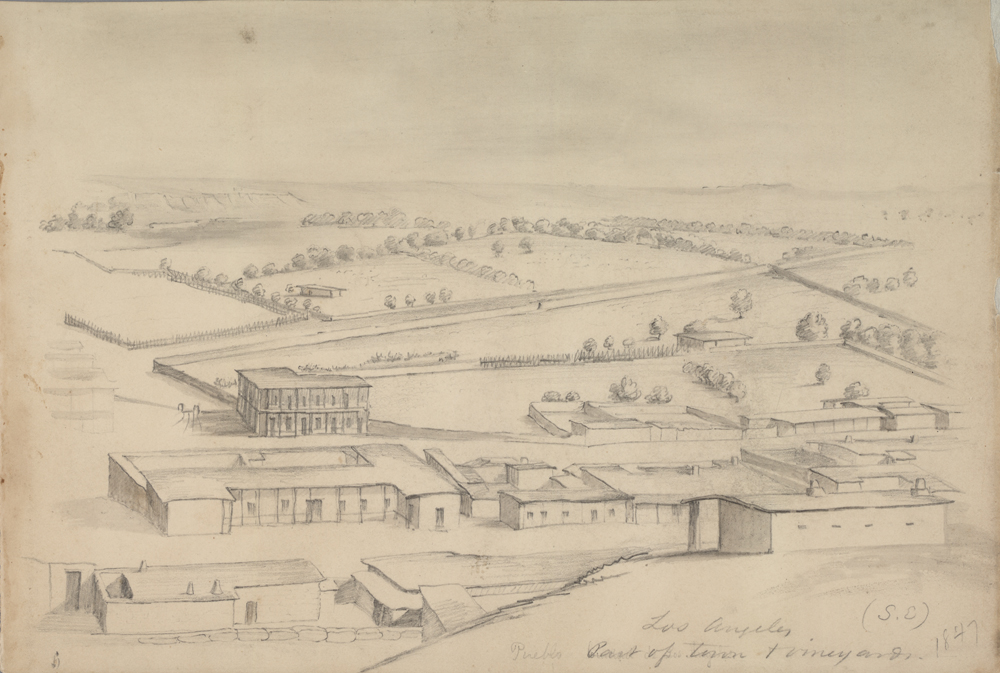
–Let's knock about town a little more, courtesy details from Kuchel & Dresel's 1857 view of L.A. Though in 1857 Los Angeles had fewer adobe structures and more frame buildings, we can still get much of the feel of how the cityscape had been a mere decade before. In the following series, our standpoint is a rooftop at about Main and 1st Streets. First, we look up and to the left, where the old calaboose presides in its minatory way over town. Above and beyond it can be seen, with some careful scrutiny, a bit of what remained of the defenses surrounding Fort Moore. Immediately before us is the "new" Temple Block at the junction of Spring, Main, and what would become Temple Streets.

–Lowering our gaze to look down at the street, we again see the "new" Temple Block (the "old" Temple Block is beyond it, and extending to the right), and now see, below us, the roof of the original structure of the U.S. Hotel, which hotel persisted, rebuilt, well into the 20th Century).
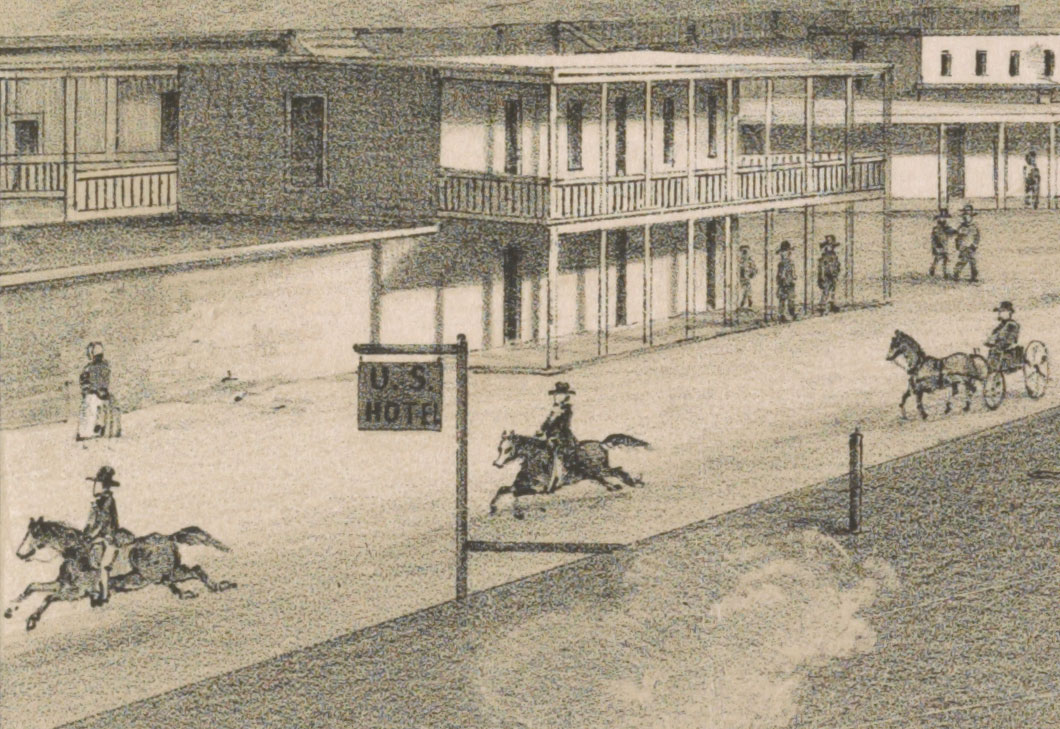
–The west side of Main St. between the Temple Blocks and the Plaza Church is not often depicted. The long building to the left is the old Temple Block, which would eventually become the Downey Block. Continuing to the right, this would have been the location of the De Celis and Salazar properties in Botello's time; later, the Lafayette Hotel would be found here. The building in the lower right corner, of which we see just the roof, will feature in Botello's narrative as the location of Arnaz's store; just beyond, next door to it, of which we can see almost nothing, is the building which was originally Isaac William's adobe, then (often) the "Government House" in the Mexican era, and finally the Bella Union Hotel. Further beyond, we see the bell tower and south wall of the Plaza church; and, beyond that, the building which was probably the site of the murder of Mr. Fink, detailed by Botello in the last paragraphs of his work.

–Now we come to the most interesting Plaza area. At left is, as we saw above, the Plaza Church etc. To the right, across Main St., is the Segura adobe. Continuing to the right, we come to what would eventually be Olvera St. The artist does not depict in this direction anything beyond the row of buildings immediately north of the Plaza; otherwise we would get a sidelong view of the Avila Adobe on Olvera St. On the right-hand side of that street, we see the adobe which was originally that of Tiburcio Tapia and later that of Agustin Olvera. The two-story structure which appears to be immediately to the right of the Tapia adobe is actually on the near (south) side of the Plaza, and is the home of Vicente Sanchez. To the right of that, we see the side of the Lugo adobe on the east edge of the Plaza. Alas, we can't see anything of the Plaza itself.

–Continuing to the right from the above (near top left, we see just a bit of the corner of the Lugo adobe), the central feature in this view is the long colonnade of posts running along the east face of the Calle de los Negros, a full view of which is blocked by Coronel's adobe at Coronel Corner. Beyond, we see open fields, which likely were actually vineyards. L.A. was to some degree surrounded by vineyards; the sweet smell of the vine flowers, and then of the ripening grapes, would combine with the aroma of the native chaparral to give L.A. a delightful air.

–And so we return to the Bell Block, from yet another angle. This colonnade of posts marks the east face of Los Angeles Street. Again we see the fields beyond, which were largely vineyards.

–Los Angeles Street continues to "drag its slow length along." The frame houses seen in the background would not have been there during the era of Botello's narrative. The gentleman sitting on the boardwalk at lower right is resting from our tour of the town; but I promise him and you that this little survey is nearly done.

–The gentleman does not believe me!–and so keeps his seat at mid-left. But we continue south on Los Angeles Street. We might pause, however, to gaze at the great old Aliso tree at upper right, the namesake of today's Aliso St., and, long ago, the gathering-place for the native Americans of Yang-na.
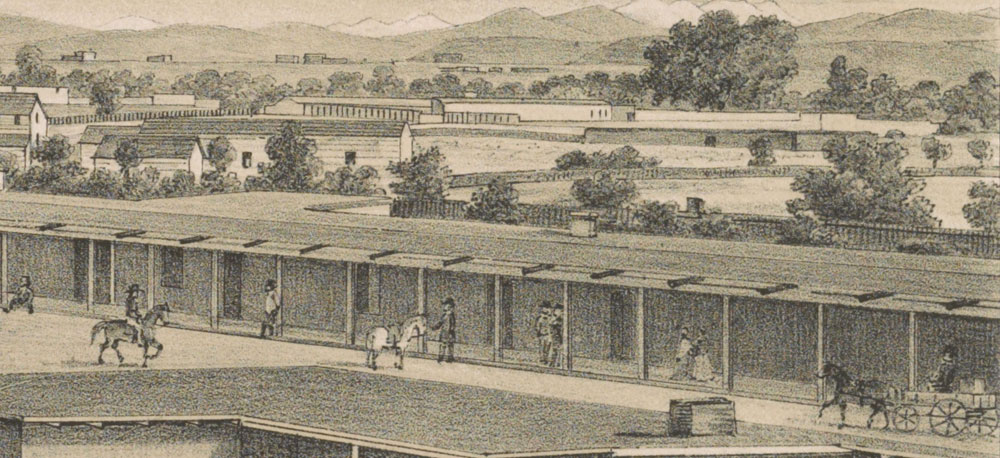
–And so we have circled back to the immediate environs of Main Street and First, where a hospitable family is gathering in their backyard to refresh us with their delightful conversation and–I hope–some cool drinks.
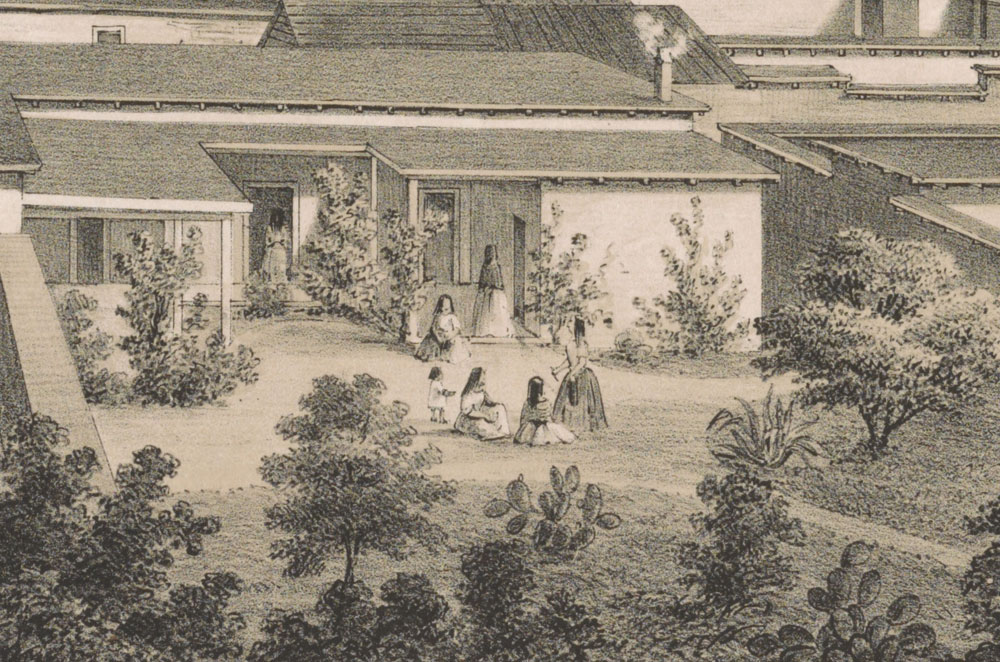
¶ 8.
–Mr. Abel
Stearns: And now for the owner of the previously-mentioned
El Palacio: Below, Abel Stearns in middle age and in old age.
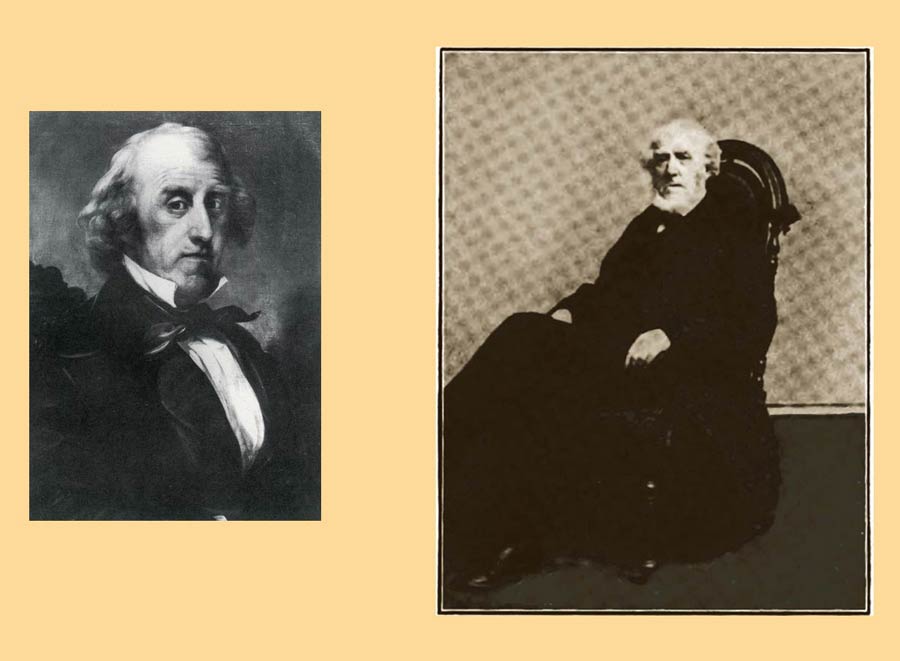
–the house of Mr. Abel Stearns: Which is to say El Palacio, below, as it appeared in 1857 (I think the lamp is the only innovation).
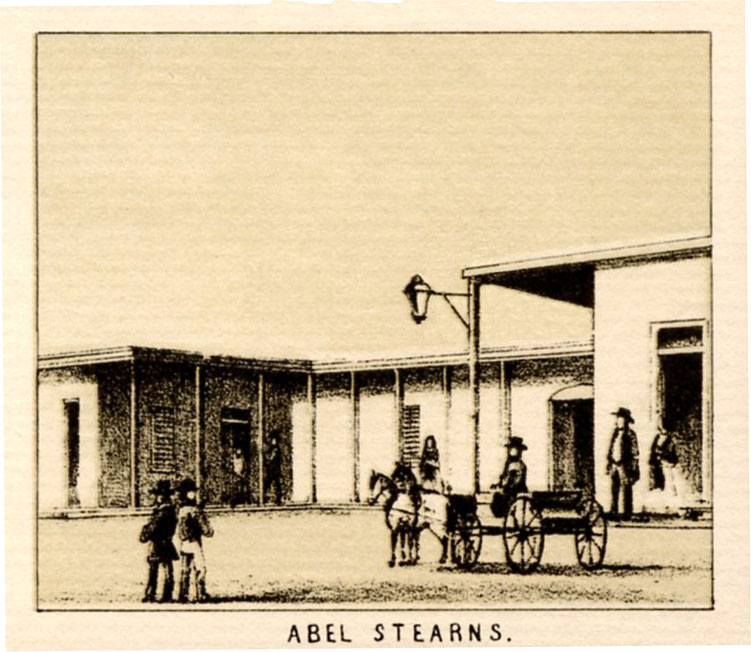
¶ 10.
–A simplified map of
central Los Angeles giving an idea of the area ca. 1833-1847,
with features from various years (for instance, the Fort was not there
until the end of the period). Stearns' El Palacio is the structure
immediately north of Government House. Government House was, earlier,
Isaac Williams' adobe, and, later, the Bella Union Hotel. The Jail is the
rectangle at the top of the hill to the left of Government House (and, on
the map, below and to the right of the Fort). Observe the slopes of the
hills and ponder well the direction of the water runoff during and after a
rain. The old plaza–the one which preceded the one on the
map–was located at the site which is under the word "Rectory" on the
map; one can see how the water runoff from the adjacent wide slope of
Loma de las Mariposas (Fort Hill) would have been directed largely
at the site of the old Plaza, the flooding which prompted the change of
plaza location.

–A map (below) of the plaza and commercial area of 1833-1847 Los Angeles, indicating some sites and residents pertaining to our tale.
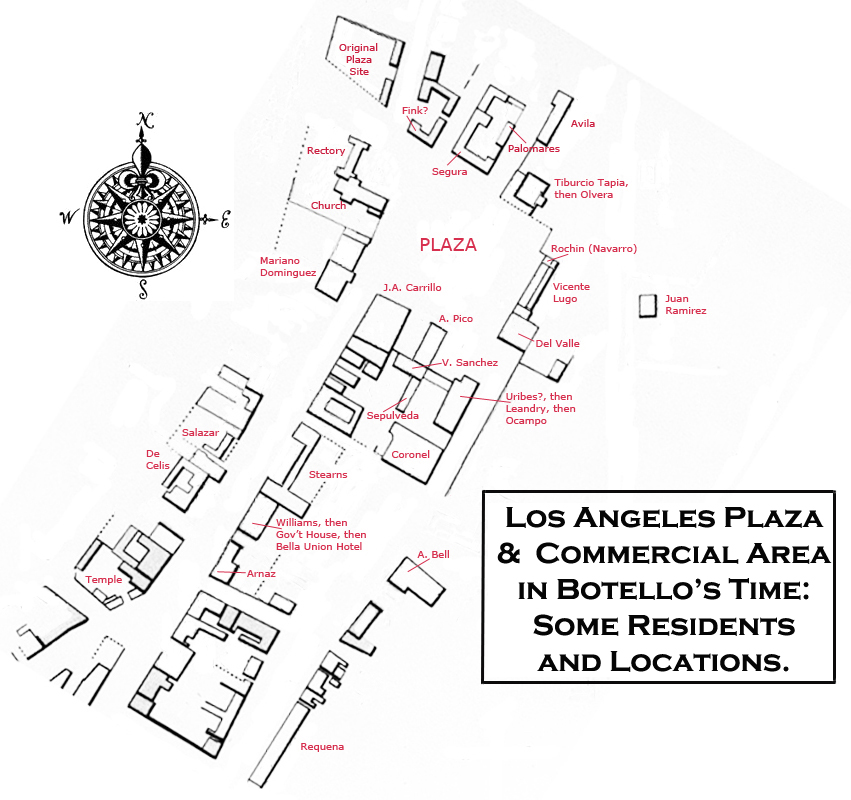
¶ 16.
–Day was arrested, taken
to prison, put in a cell, and shackled: In a view from 1857,
we see (behind and above the later Lafayette Hotel) Day's prison, L.A.'s
venerable calaboose. The old jail was later turned into a residence in
which the future Mayor Eaton was born.
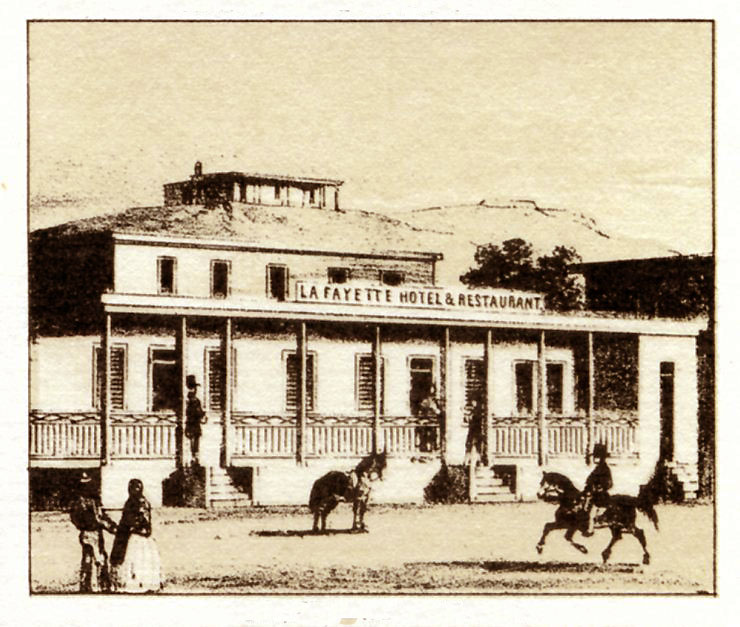
¶ 17.
–"was left vacant and
remained" would probably be better rendered "be left vacant and
remain".
¶ 19.
–Don Tiburcio
Tapia: Some more on Don Tiburcio: 1829, "We stopped at the
house of Don Tiburcio Tapia, the 'Alcalde Constitucional' of the town,
once a soldier in very moderate circumstances, but who by honest and
industrious labor had amassed so much of this world's goods, as to make
him one of the wealthiest inhabitants of the place. His strict integrity
gave him credit to any amount, so that he was the principal merchant, and
the only native one in El Pueblo de los Angeles" [Alfred Robinson, Life
in California, p. 63].
–"The insisted"
should be "They insisted".
¶ 20.
–Brigadier-General Don
Jose Figueroa: A little information has come to hand about
Figueroa's career prior to his arrival in California. In the latter part
of 1811, then-Colonel Figueroa, under Morelos and Trujano, was spreading
the revolutionary insurgency to Tehuacan, in the state of Puebla, Tehuacan
being "the commercial centre of the provinces of Puebla, Oajaca, and Vera
Cruz" (History of Mexico 1804-1824, by H.H. Bancroft, p. 398).
February, 1821, finds him being sent by Iturbide on a mission to negotiate
with Guerrero (op. cit., p. 708). August 9, 1824, as President of
the Congress of the State of Mexico, he was a signatory to a provisional
organic law (History of Mexico 1824-1861, by H.H. Bancroft, p. 22).
In Fall, 1825, he was leading three hundred or so men in a campaign
against the Yaqui Indians in the area around Tubac, Tucson, and the Gila
River (see the site Tubac Through Four Centuries, by Henry F.
Dobyns); by August 31, 1826, he was comandante at Arizpe in
northern Sonora (see The Taos Trappers, by David J. Weber, p. 114).
Referring to about the same time, Hardy (Travels, p. 126) writes,
"In the neighborhood of Babiacora [Baviacora, Sonora], General
Figueroa is working a silver mine which formerly produced a great deal of
metal; but the Commandant General has not yet found it very productive,
besides an expensive outlay." Further biographical information may be
found in Bancroft History of California 3:234 (footnote), where ,
in the main text, Bancroft makes the comment "it is believed that his
appointment [as governor of California] was a measure dictated less
by a consideration of his interests or those of California than by a
desire to get rid of a troublesome foe."
¶ 26.
–green
spectacles: "The road from hence to the port [Guaymas]
is very sandy, and the reflection of the sun from the sandy soil is very
distressing to the eyes. Indeed this observation applies to all the roads
in the republic whereon I travelled in my various migrations, which were
neither few nor short. Strangers to the country use coloured spectacles,
which in some degree obviate the inconvenience" (Hardy, Travels in the
Interior of Mexico, p. 226).
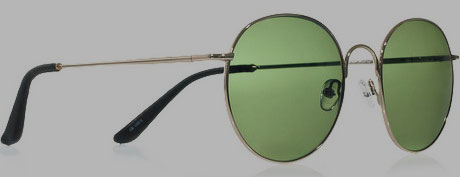
¶ 27.
–his wife, Maria del
Rosario Villa–la Chala: Who might have looked like this,
La Chiera, from the 1855 Mexicanos Pintados por si
Mismos. Note the cigarette.
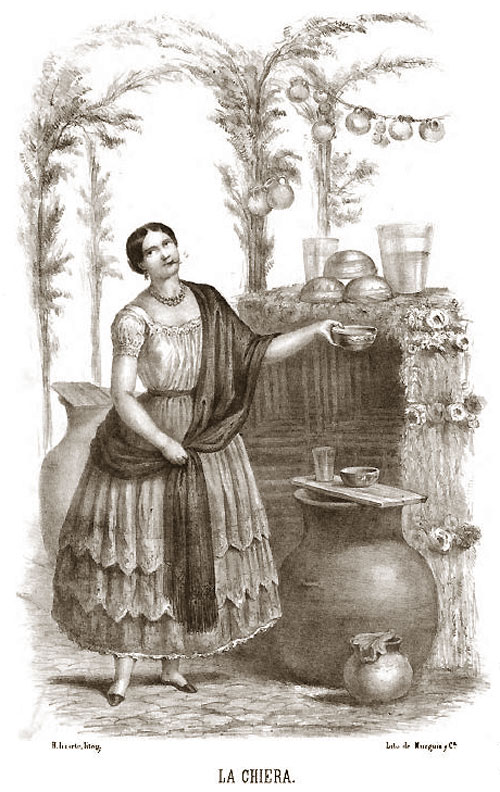
¶ 28.
–Gervacio [Alipas] [...]
was employed as a cowboy: And might have looked like
this, Claudio Linati's depiction of a Mexican caballero.

¶ 28-29.
–General
remarks: Many of these details could only have come from
Alipas and/or la Chala, presumably in statements made while in
custody and in response to the inevitable question, "What happened?".
¶ 29.
–his legs remained
uncovered: Something that happened during the burial, or
some consideration, made Alipas and la Chala leave prematurely.
Perhaps they saw or heard the wood-collector about to be mentioned
approaching in the distance.
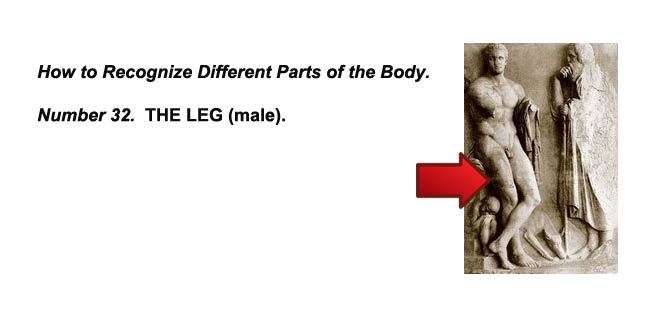
¶ 30.
–the skillful Antonio
Ignacio Avila: Jose Antonio Ygnacio Avila, usually known as
Antonio Ygnacio; ca. 1776-1783, born at Villa del Fuerte, Mexico; parents,
Cornelio Avila and Maria Ysabel Urquidez; by 1783, present in California
with his parents; by 1799, present in L.A., when given land; February 6,
1803, married Rosa Maria Ruiz at Santa Barbara presidio; 1804, resident in
L.A.; 1810-1811, soldier in L.A. militia; February, 1816, present in L.A.,
evidently living at Rancho San Pedro; August, 1816, as a member of the
L.A. militia, serving at San Diego presidio; 1818, involved at Santa
Barbara and San Juan Capistrano in the defenses against oncoming pirate
Bouchard; 1820, 1821, regidor in L.A.; ca. 1821, present in L.A. with wife
and seven children; the "tract called Sauzal Redondo was temporarily
granted by the commandant of Santa Barbara in 1822 to Antonio Ygnacio
Avila, the land apparently belonging to the pueblo" (regranted 1837);
1823, present in L.A. in the militia; 1823, on church compliance list in
L.A.; evidently the Antonio Ygnacio Avila (Abila) mentioned in the 1824
will of Jose Bartolome Tapia concerning a transaction of 1823 involving
Antonio Briones (Priones); 1835-1848, juez de campo most of the
time, "and always prominent in the pursuit of Ind. horse thieves," quoth
Bancroft; 1836, present in L.A. as a ranchero; 1836-1837, of the
anti-Alvarado faction; January 15, 1837, Osio borrowing "one of Don
Antonio Ignacio Avila's very fine horses, which he called
gutierreños"; May 14, 1838, going to visit Pio Pico who was
imprisoned at the Home of Jose Antonio Ezequiel Carrillo; December, 1839,
evidently in prison, or having been in prison, as Joaquin Ruiz was tried
then for attempting to release him; 1842, juez de campo. 1842,
contributing towards the cost of provender for Michelorena's
batallon; 1844, present in L.A. as a laborer and landowner; 1845,
1848, juez de campo; 1850, present in what was to become east
Orange County as a grazier; September 25, 1858, died; September 26, 1858,
obsequies at Plaza church; October 2, 1858, published (Los Angeles
Star): "Died, on Saturday last, the 25th ultimo, in this city, at the
residence of Don Ygnacio Del Valle, Don Antonio Ygnacio Abila. His age was
not known, but he is supposed to have been over ninety years old. He was
born in the Villa del Fuerte, Mexico, and came very young to California;
served his country as a soldier, and by industry and integrity accumulated
great wealth, the greater part of which he gave away in works of charity.
In him the poor always found a sympathizing friend and protector. His
remains were escorted to their last resting place on Tuesday morning, by a
large concourse of citizens. The funeral services were performed in the
church by Rev. Father Raho and the other clergymen of the city. The direct
descendants of deceased number over one hundred and twelve"; children:
Maria, Maria Francisca de Paula, Maria de la Asuncion, Josefa, Juan, Jose
Martin, Maria Rafaela, Maria Ascencion, Pedro, Maria Marta, Dionisio de
Pilar, Higenio; illegitimate child with Maria Gregoria Matilde Cota: Maria
Antonia (last name also seen as Rendon); illegitimate child with Josefa
Castro: Jose del Carmel; son Juan Avila, dictating to Bancroft's worker
Thomas Savage within days of Savage's recording of Botello's material,
discusses his father, from which here is an extract (translation by
Alfonso Yorba, published in the 1939 Orange County History Series No.
3, p. 1): "My father was juez de campo from early manhood, in
the jurisdiction of Los Angeles, until his advanced age no longer
permitted him to mount a horse. Many times he asked to be relieved,
particularly in his last years, but the people insisted that he remain in
office, and there was no other remedy than for him to do as they asked. On
almost every occasion in which the people of Los Angeles had to send
expeditions, be it against thieves or against insurgents, deserters, or
criminals, he went at the head, because he was not only a man of great
activity and energy, but also because he was a good tracker, a faculty
which he did not lose up to the last moment of his life." Almost
undoubtedly, Duhaut-Cilly, writing of ca. April, 1827, refers to Avila in
this passage from his A Voyage to California..., referring to three
criminal Indians whom he had been entrusted to convey to San Diego:
"[While Duhaut-Cilly was anchored at San Pedro,] they were clever
enough to steal the only boat lying alongside the ship and, after first
letting themselves drift noiselessly away, they disappeared without being
noticed by the two seamen of the watch. As soon as I was informed of the
matter I sent two boats in search of the one they had taken, and it was
found abandoned on the rocks of Point San Vicente but without damage.
[...] I learned later that after wandering for several months in these
deserted hills they had finally been recaptured by a ranchero of the
neighborhood [note the reference above to Avila's tract of "Sauzal
Redondo"], well known for exploits of this kind. He made the poor
Indians pay dearly for the several cows they had killed for food; catching
them by surprise one day, he succeeded in garroting two of them
[doubtlessly via lassoing them] and put a bullet between the
shoulders of the third, who was fleeing" (Duhaut-Cilly, A Voyage to
California, translated and edited by August Frugé and Neal
Harlow, 1997, 1999, p. 92). So we understand all the better Botello's
reference to "the skillful Antonio Ignacio
Avila."
–doubtlessly by lassoing them in the above footnote about Avila: "This noose or lasso, used in all the Spanish possessions of the two Americas, is a leather rope as big around as the little finger and fifteen to twenty fathoms in length [75 to 120 feet]. While one end is fixed firmly to the saddle-bow, the other is tied in a running knot. For anyone other than these skillful riders such a weapon would be quite useless; in their hands it is a powerful and formidable arm. With it they have been known to confront the lances and bayonets of regular troops. [...] When a man wishes to use the lasso against an animal or another man, he holds it coiled in one hand while he gallops within fifteen feet of the enemy, whirling the lethal loop over his head like a sling. And at just the right moment he casts it with such skill that he never fails to bind the neck or the body or the legs of the one he wants to catch, and whom he drags cruelly along the ground as his horse gallops on" (Duhaut-Cilly, op. cit., pp. 69-70).
–gutierreños in the above footnote about Avila is uncertain in its signification. It's possible that Avila somehow came by the horses through Lt. Colonel (and sometime governor) Nicolas Gutierrez, commanding the soldiers based at Mission San Gabriel.
–as a ranchero (in the note above about "the skillful Antonio Ignacio Avila"): An image by Carl Nebel of Rancheros, from 1836 (below).
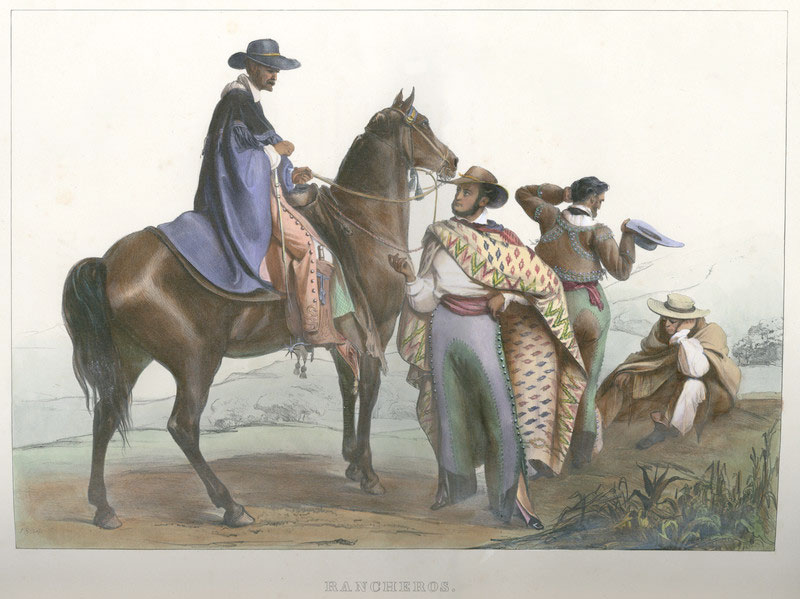
¶ 31.
–All of this caused an
uproar in town. [...] Everyone was crying bitterly: Aside
from political shenanigans, crime per se was extremely uncommon in
California at this time. A murder was profoundly shocking to society in
general: "From 1819 to 1846, that is to say during the entire period of
Mexican domination under the republic, there were but six murders among
the whites in California. As in the golden reign of England's good King
Alfred, a log cabin could hold all the criminals in the country. There
were then no jails, no juries, no sheriffs, law processes, or courts;
conscience and public opinion were law, and justice held an evenly
balanced scale" (from Bancroft's Popular Tribunals, Vol. I, 1887,
p. 62). In this specific case, "Horror and indignation took possession of
all minds, and while for the murdered man the mercy of God was
implored, exemplary punishment for the murderers was debated. [...]
Some were desirous that the criminals should be immediately executed;
but their ardor was restrained by the greater prudence of others, who
reminded them that such proceedings could only be excused on the
ground of necessity, and when carried out with coolness and in
accordance with the rules and principles of strict justice. The wisdom
of these suggestions was acknowledged, and the threatened outbreak
checked. On the 30th the funeral of Feliz took place, and the occasion
gave rise to a renewal of the popular clamor. Nothing but the
assassination was talked of, and the sentiment was fully approved that
an example was necessary to prevent the possible occurrence of similar
crimes. But holy week was at hand, and it was thought it would be
tantamount to sacrilege were the blood of so foul an assassin to stain
the remembrance of that most solemn of tragedies. Therefore the first
work-day after Easter, which would be the 6th of April, was fixed on
as that of the execution. A heavy storm which raged during the whole
of that day made postponement necessary, but on the 7th, at an early
hour, the most respectable men of all classes of the community
assembled at the house of John Temple. A Junta Defensora de la
Seguridad Publica, or Board of Public Security, was organized.
Victor Prudon, by birth a Frenchman, but a naturalized citizen of
Mexico, was chosen president. Manuel Arzaga, ex-secretary of the town
council, was elected secretary, and a retired officer of the army,
Francisco Araujo by name, appointed military commandant. [...] It was
then determined that both the man and the woman should be shot. The
junta was declared to be in permanent session until such time as the
object which called it into being should be accomplished, and measures
to that end were after discussion unanimously concurred in. At two
o'clock a sub-committee, with a copy of the resolutions, waited on the
alcalde, who thereupon convened the town council. At three o'clock, no
communication having been received from the alcalde, a message was
sent by the junta to that official, notifying him that the time
allowed for his action had elapsed, and informing him that the
resolutions of the junta were about to be carried into effect. No
answer was returned; but the second alcalde, accompanied by the
treasurer and another member of the council, appeared before the
junta and desired to be informed if that body recognized the legally
constituted authorities, and if so, what might be the significance of
this illegal assembly of armed men. The former question was answered
in the affirmative, and the answer to the latter, the magistrate was
informed, was contained in the resolutions which had been sent to the
first alcalde. At half-past three, by order of the junta, peaceable
possession of the guard-room of the jail was taken. No answer had yet
been received from the first alcalde, although he had sent a member of
the council to invite the president of the junta to a conference, to
which request answer was made to the effect that, apart from the
junta, the president was not at liberty to enter into negotiations. At
four o'clock both alcaldes made their appearance before the junta; a
resolution of the council condemnatory of the proposed illegal action
was read, and an attempt made to dissuade the junta from its purpose.
Convinced that their efforts were useless, the authorities withdrew,
after enjoining on those present the preservation of order, and
receiving the assurance that all measures necessary to that end had
been taken. [...] The military commandant was more compliant than the
alcaldes; he caused arms to be given to the firing party, and gave
orders necessary to the occasion. At half-past four the president of
the junta ordered Alipas to be brought forth for execution. Already
his irons had been filed so deeply that a single blow of the hammer
released his hands. The man was then shot, and after him the woman"
(op. cit., pp. 63-66).
¶ 41.
–formed a governmental
plan: This image, the 1855 Mexicanos Pintados por si
Mismos's El Cómico de la Legua studying his script, could
just as easily serve as an illustration of one of the era's
políticos preparing his latest manifestación.
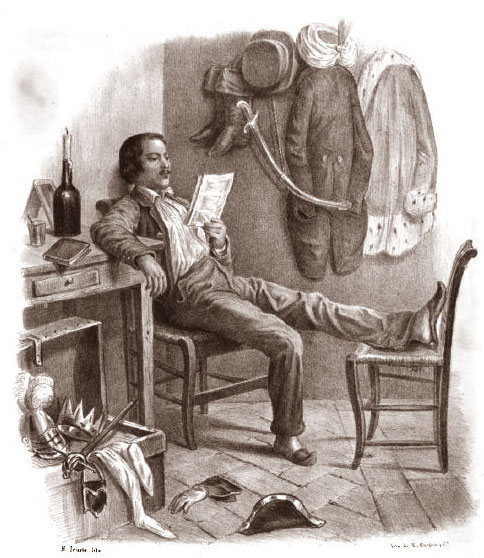
¶ 54.
–Bandini [...] went with
a few men to Sepulveda's house in order to arrest him: Below,
Don Jose hospitably awaits visitors on his doorstep. Image from 1857.
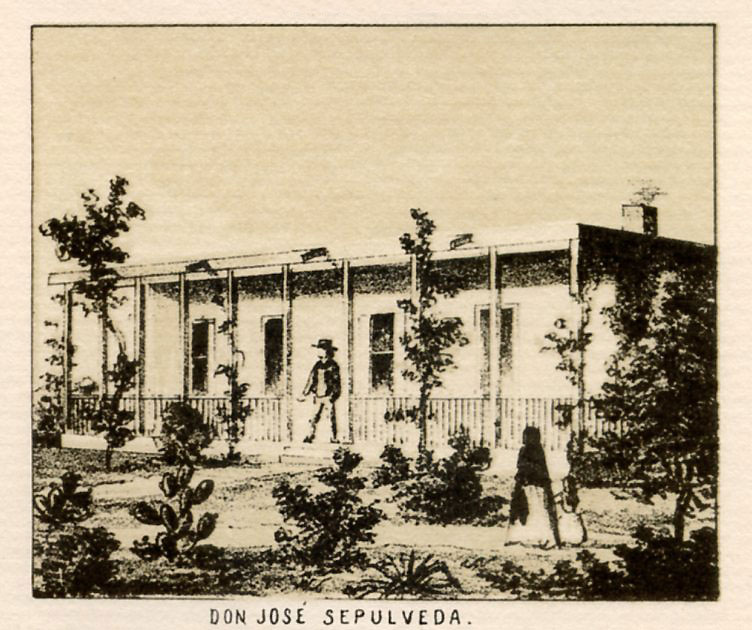
¶ 60.
–in command at San
Gabriel: Naturalist Ferdinand Deppe's 1832 oil of Mission San
Gabriel and its surroundings, below. The painting is now in the
collection of the Laguna Art Museum.
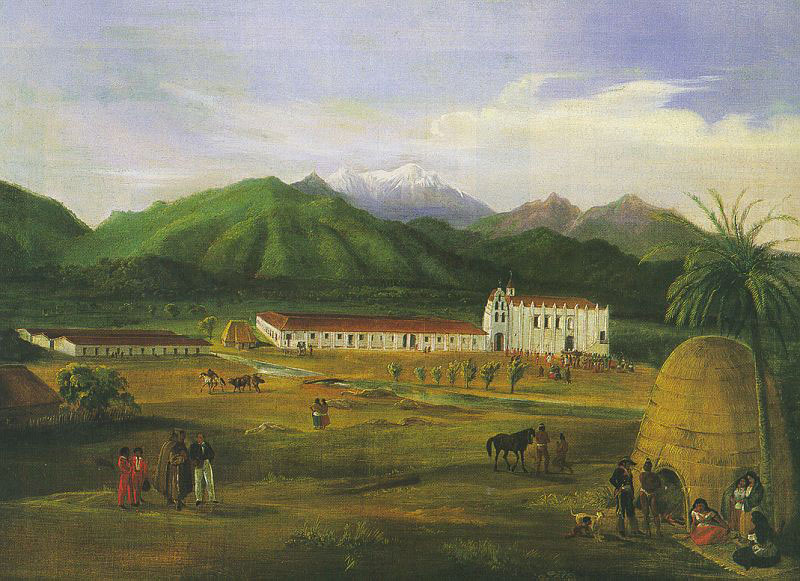
¶ 73.
–where was the rubric of
the President of the Republic?: Here it is (below), the
signature and rubric of Anastasio Bustamante.

¶ 79.
–we
withdrew to San Buenaventura: Below, from
Alfred Robinson's Life in California, San
Buenaventura.
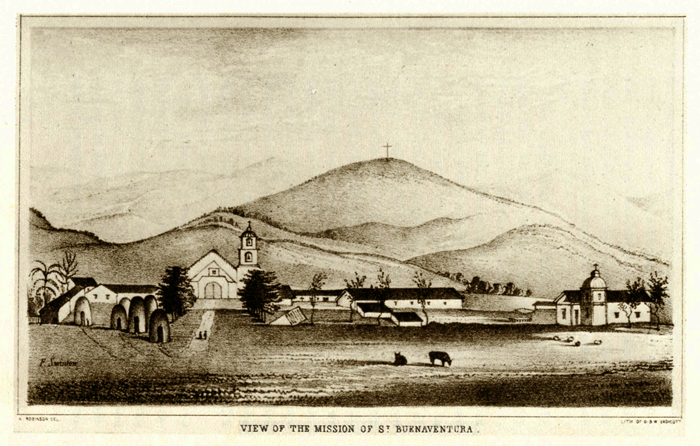
–San Buenaventura: Another angle on San Buenaventura, this time as it would appear to those arriving from the south, courtesy Edward Vischer.
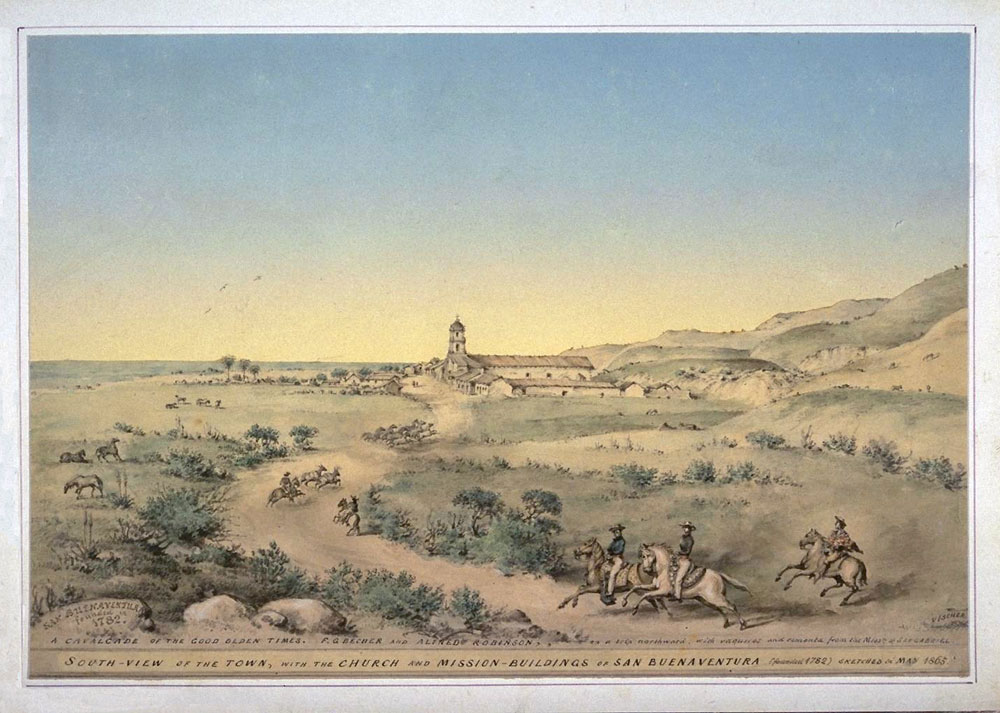
–the mission road was impassible by foot: "The morning after, we set out on an excursion to St. Buenaventura. The road thither is partly over the hard sandy beach, and at times, when the tide is low, it is possible to perform the whole journey [between Santa Barbara and San Buenaventura] over this smooth level. We were not over two hours on the road" [p. 49, Alfred Robinson's Life in California]. Also, impassible should be impassable.
¶ 80.
–something to be taken
care of at his Rancho Los Alamitos: Below, Rancho Los
Alamitos several decades later in its years of ownership by the Bixby
family. We look west towards Palos Verdes. The clump of trees near the
middle in the distance is probably the neighboring Rancho Los
Cerritos. The land mass at upper left corner is part of Catalina. The
"mountain" in the distance at mid-right would be Signal Hill.
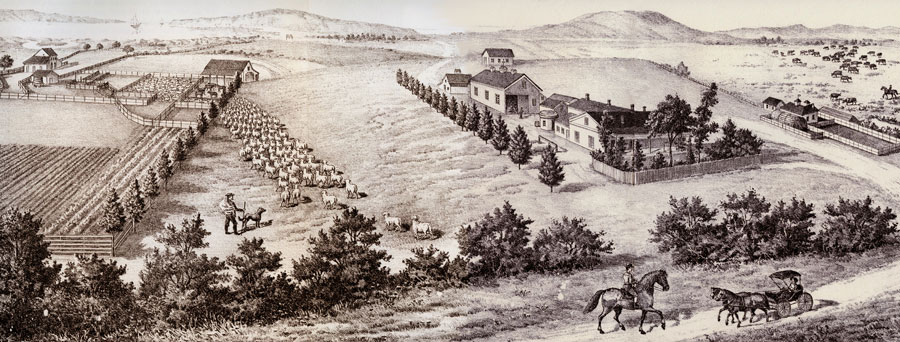
¶ 82.
–Ayala: Due to
mention of Ayala in the memoirs of Victoriano Vega, it is now certain
that this Ayala is Juan Pablo de los Santos Ayala, information on whom
can be found in the Botello book's notes to ¶ 134.
¶ 85.
–it was Don Juan
Avila: Avila himself recalls this in his Notas
Californias dictation for Bancroft: "When it was known in Los Angeles
that our force [at San Buenaventura] was threatened by the enemy, Governor
Carrillo asked for reinforcements and about twenty of us set out under the
command of Don Pio Pico. We got as far as the Santa Clara River where we
came upon some fugitives on foot who gave us news of our forces having
surrendered."
¶ 91.
–I reached San Juan
Capistrano: Below, a map of the San Juan Capistrano plaza
area, much simplified, showing various features selected from the era
1840-1860. I have made an effort to include some details which
particularly relate to something which will be of interest to many
historians, namely the locations of those involved in the January, 1857,
incursion of the Juan Flores/Pancho Daniel gang. The highly attractive
lines of buff-brown blobs indicate roads and paths. The road to the Hot
Springs is also the road to the Temecula area, Mission San Luis Rey, and
San Diego. The usual Los Angeles road would be what exits this map at the
top, which proceeds in that direction through the various Santa Ana
ranchos and so on.
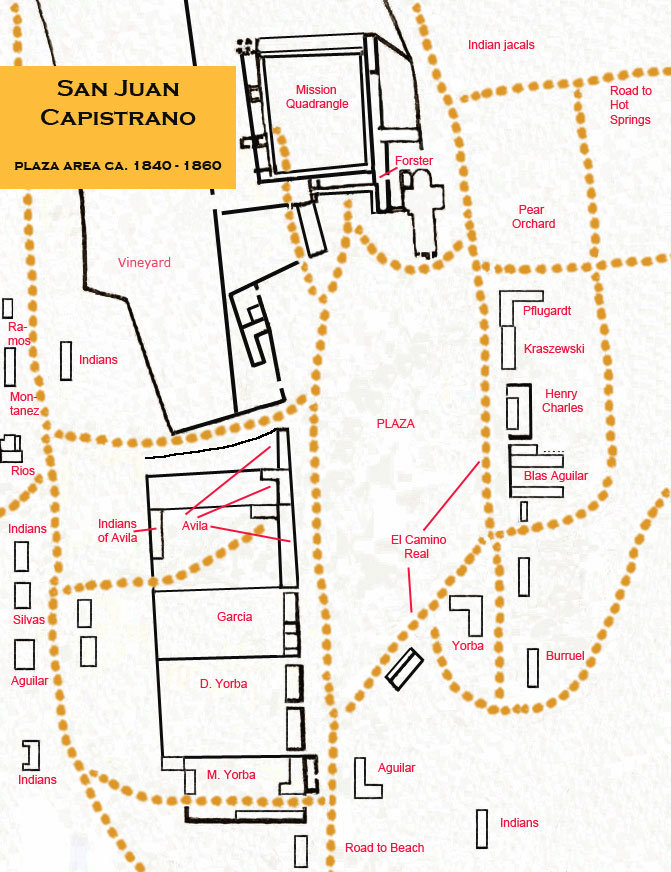
–San Juan Capistrano: A view by Edward Vischer of the area between the old barracks and the ruined stone church.
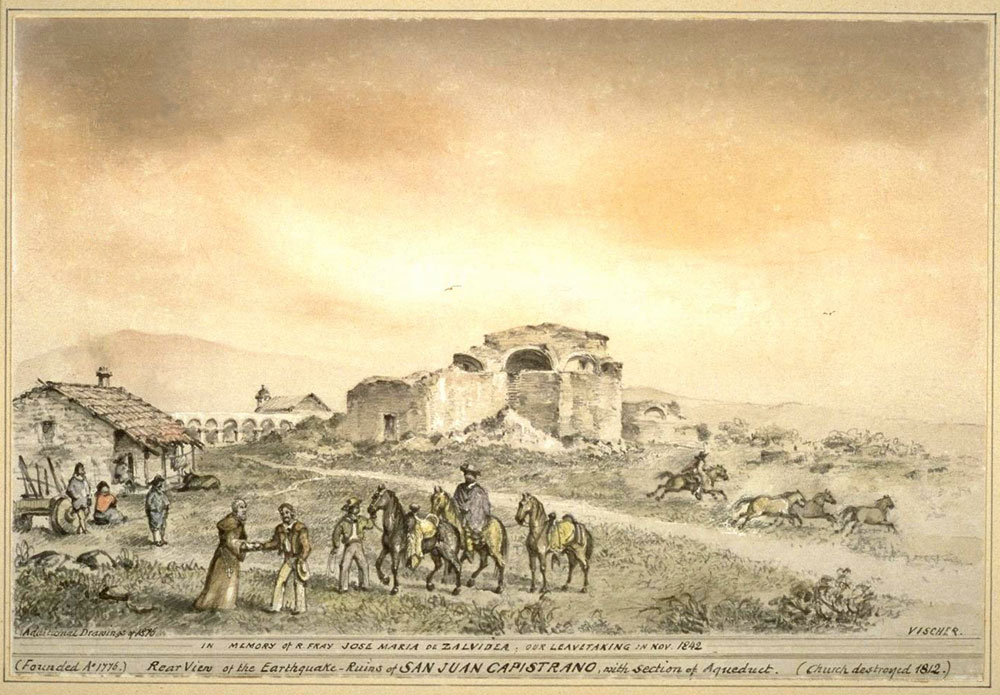
¶ 92.
–There was another
captain here by the name of Captain Agustin Vicente Zamorano:
Don Agustin obliges us by providing a self-portrait (below).
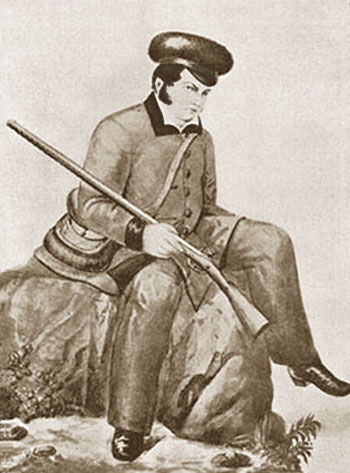
¶ 93.
–A map of the San Diego
Plaza area.

–he followed the troops to San Luis Rey, where he lived: Below, William Rich Hutton's drawing of Mission San Luis Rey in 1848 (image courtesy the Huntington Library, San Marino, California, call number HM 43214 20, used by permission.)
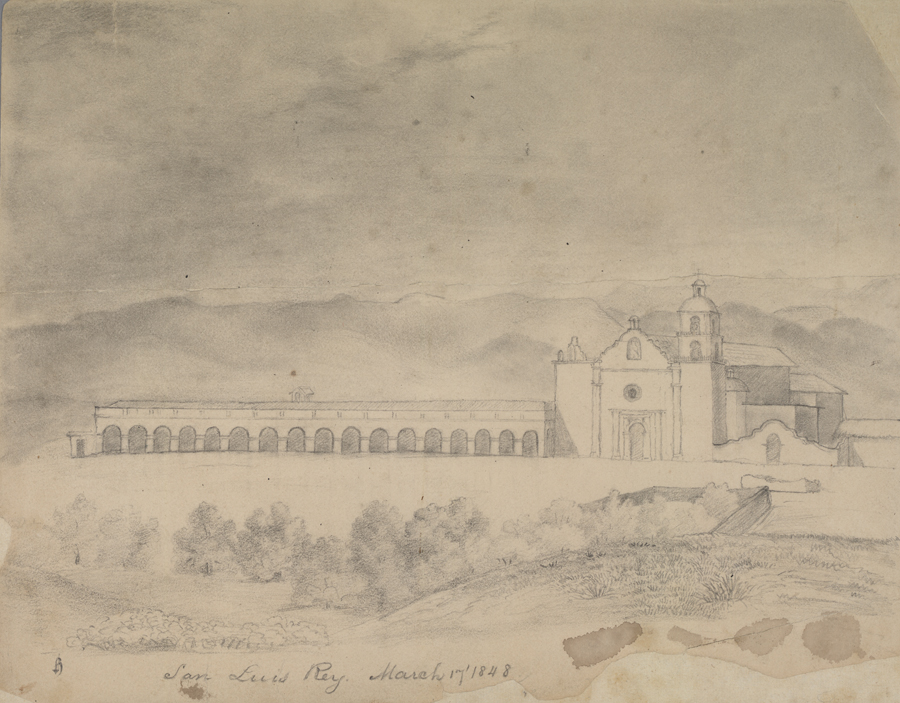
– Las Flores (a rancho belonging to San Luis Rey): Below are the ranch buildings, including the San Pedro Chapel, of the estancia Las Flores on Rancho Las Flores, as they appeared circa 1850. The belltower was prominent enough during its existence that mariners used it as a landmark. "It is situated on an eminence commanding a view of the sea, with the distant islands St. Clemente and Catalina, and overlooking an adjacent level, extending for miles around, covered with thousands of animals grazing" (from Alfred Robinson's Life in California, published in 1846, but this passage refers to Robinson's travels in 1829). Second below is a plan of the Las Flores compound grounds, from Zephyrin Engelhardt's San Luis Rey the King of the Missions. The rancho is Las Flores; the chapel in the Las Flores ranch-house complex is the chapel of San Pedro.

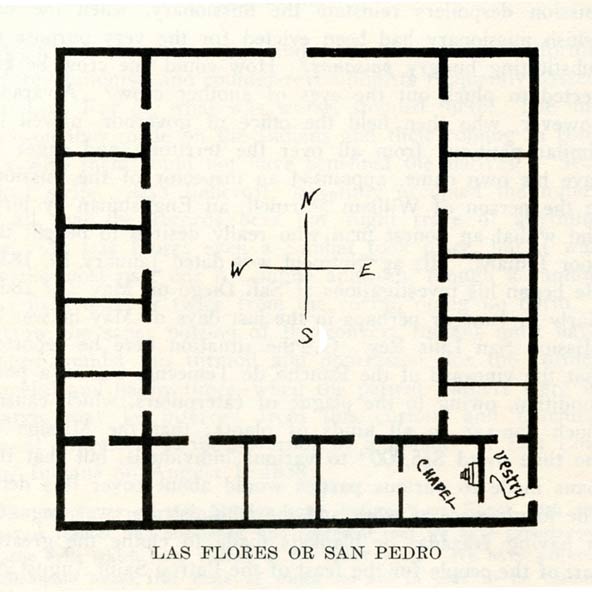
¶ 97.
–General
remarks: "[I]t requires careful examination to know
thoroughly the character of a Mexican. From whatever cause it may arise,
whether from apathy or self-willed obstinacy, from desire to use the power
of action, and not of reflection, which independence has bestowed upon
them, and of which they make a most licentious use; certain it is, that an
examination into the principles of justice is no concern of the partisan.
The feeling of the moment is quite sufficient for his enlistment, either
on the right side or the wrong; and the direction even of his thoughts is
left to the leaders of either faction–I say faction, because that is
the proper term applicable in Mexico, to what in other countries may be
termed party. In Mexico, a thing may be morally right and
politically wrong; and as political dogmas are, for the most part,
unintelligible, by a singular perversion of good feeling they are usually
adopted" (Hardy, Travels in the Interior of Mexico, p. 106).
"[P]ersons of Spanish heritage preserve an intense localismo,
or respect for one's own locale or district, a deep belief in
personalismo, which glorifies the individual over an abstract
principle, religious and familial practices, and an intense
preoccupation with the present, not generally shared by their Anglo
counterparts" (this latter quote from site California During
the Revolution, by Leon G. Campbell).
¶ 101.
–old lady
Urquides: Perhaps Señora Urquides looked somewhat like
this...

¶ 102.
–the town of Santa
Barbara: Image from Alfred Robinson's Life in
California.
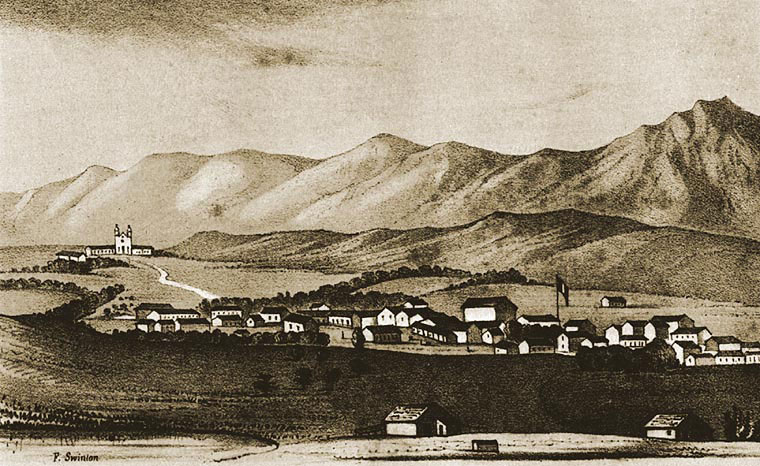
¶ 106.
–we [...] arrived at
Mission San Luis Obispo about noon: Below, William Rich
Hutton's view of Mission San Luis Obispo, as it looked in 1850. (Image
courtesy the Huntington Library, San Marino, California, call number HM
43214 (43), used by permission.)
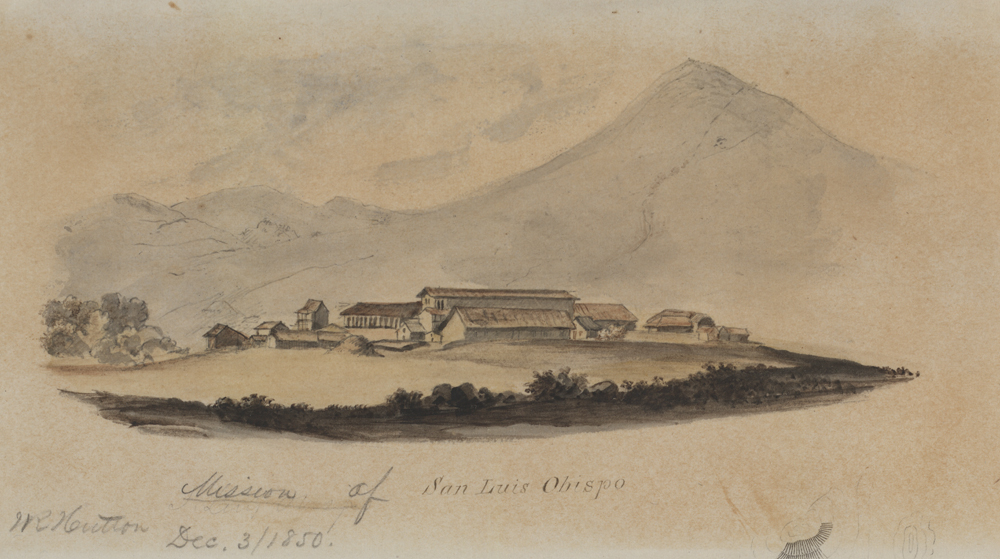
¶ 108.
–In
Sonoma: Below, a look at Sonoma's plaza, with Vallejo
reviewing his men, his residence at center with the castellated tower, and
Mission San Francisco Solano, where the prisoners were held, at right.
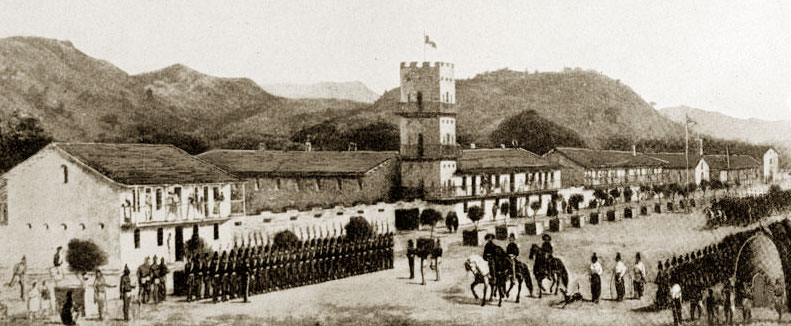
–the hall of the mission: This could refer perhaps to the refectory in the padres' quarters (see below), or possibly to what the old 1824 church was being used for at the time.
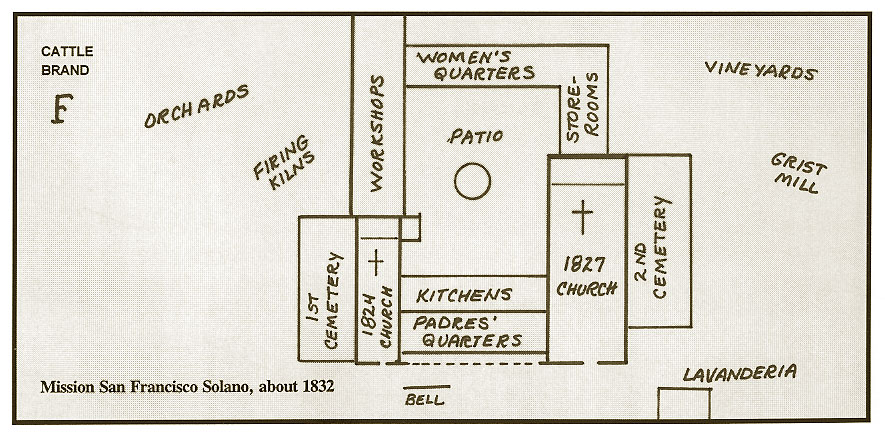
¶109.
–He was an excellent
barber: Padilla would have been rather younger; but, below,
El Barbero, from the 1855 Los Mexicanos Pintados por si
Mismos.

¶ 110.
–The room was at the
rear of the mission: This was surely a room in the old
monjero or Women's Quarters (see the chart above), the door of
which would indeed have faced south.
¶ 126.
–a series of
dances: At the completion of Juan Bandini's home on the
Plaza in San Diego in 1829, he held a fandango, which was
described by Alfred Robinson in his Life in California: "At an
early hour the different passages leading to the house were enlivened
with men, women, and children, hurrying to the dance; for on such
occasions it was customary for every body to attend without waiting for
the formality of an invitation. A crowd of leperos was collected
about the door when we arrived, now and then giving its shouts of
approbation to the performances within, and it was with some difficulty
we forced our entrance. Two persons were upon the floor dancing 'el
jarabe.' They kept time to the music, by drumming with their feet, on
the heel and toe system, with such precision, that the sound struck
harmoniously upon the ear, and the admirable execution would not have
done injustice to a pair of drumsticks in the hands of an able
professor. The attitude of the female dancer was erect, with her head a
little inclined to the right shoulder, as she modestly cast her eyes to
the floor, whilst her hands gracefully held the skirts of her dress,
suspending it above the ankle so as to expose to the company the
execution of her feet. Her partner, who might have been one of the
interlopers at the door, was under full speed of locomotion, and rattled
away with his feet with wonderful dexterity. His arms were thrown
carelessly behind his back, and secured, as they crossed, the points of
his serape, that still held its place upon his shoulders. Neither
had he doffed his 'sombrero,' but just as he stood when gazing from the
crowd, he had placed himself upon the floor. The conclusion of this
performance gave us an opporunity to edge our way along towards the
extremity of the room, where a door communicated with an inner
apartment. Here we placed ourselves, to witness in a more favorable
position the amusements of the evening. The room was about fifty feet in
length, and twenty wide, modestly furnished, and its sides crowded with
smiling faces. Upon the floor were accommodated the children and Indian
girls, who, close under the vigilance of their parents and mistresses,
took part in the scene. The musicians again commencing a lively tune,
one of the managers approached the nearest female, and, clapping his
hands in accompaniment to the music, succeeded in bringing her into the
centre of the room. Here she remained a while, gently tapping with her
feet upon the floor, and then giving two or three whirls, skipped away
to her seat. Another was clapped out, and another, till the manager had
passed the compliment throughout the room. This is called a son,
and there is a custom among the men, when a dancer proves particularly
attractive to any one, to place his hat upon her head, while she stands
thus in the middle of the room, which she retains until redeemed by its
owner, with some trifling present. During the performance of the dances,
three or four male voices occasionally take part in the music, and
towards the end of the evening, from repeated applications of
aguardiente, they become quite boisterous and discordant. The
waltz was now introduced, and ten or a dozen couple[s] whirled gaily
around the room, and heightened the charms of the dance by the
introduction of numerous and interesting figures. Between the dances,
refreshments were handed to the ladies, whilst in an adjoining
apartment, a table was prepared for the males, who partook without
ceremony. The most interesting of all their dances is the contra
danza, and this, also, may be considered the most graceful. Its
figures are intricate, and in connection with the waltz, form a charming
combination. These fandangos usually hold out till daylight, and
at intervals the people at the door are permitted to introduce their
jarabes and jotas. G– [William Gale] and
myself retired early [...]" Below, we see El Jarabe, by Edouard
Pingret; much further down, we have occasion to picture the
jota.
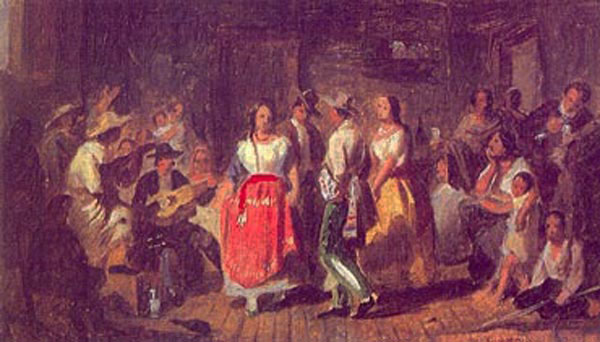
¶ 134.
–"him men" should
be "his men".
¶ 135.
–jumped onto the
wall: Below, some L.A. walls of ca. 1850, just about a block
away from the location where the incidents of Botello's narrative were
taking place.

¶ 137.
–I went to
Monterey: Below, William Rich Hutton's drawing of the main
street of Monterey in 1847. (Image courtesy the Huntington Library, San
Marino, California, call number HM 43214 (53); used by permission.)
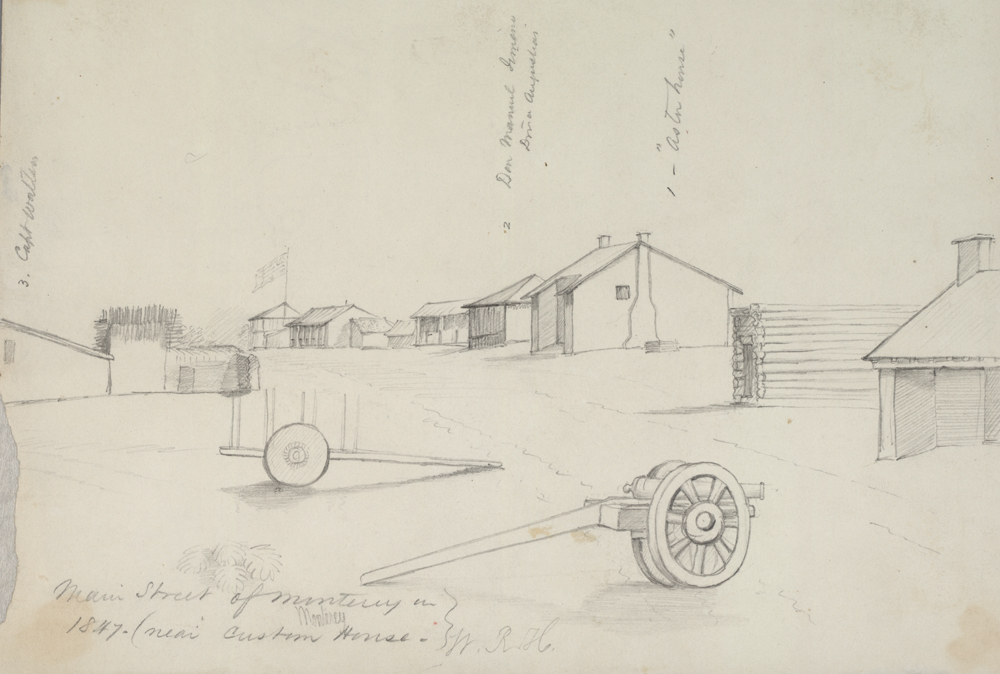
–David Spence: David Spence was perhaps the merchant Mr. Spence whom author Hardy, of Travels in the Interior of Mexico, met in Guaymas in February, 1826. "His face I thought looked sallow, and his body wasted, from the effects of poison, which, as he assured me, had been administered to him at Pitic. He is married to a lady of the country. He possesses a great deal of hearsay information, although, perhaps, he is by no means qualified to form an opinion of his own" (p. 90).
¶ 138.
–"to support of"
should be "for support of".
¶ 142.
–Castro established his
headquarters at Mission San Jose: Below, Mission San Jose,
sketched by Vischer in a somewhat dilapidated state (the mission, not
Vischer).

¶ 155.
–"Manso, who
Spaniard" should be "Manso, a Spaniard".
¶ 165.
–They arrived in San
Juan Bautista: Below, William Rich Hutton's drawing of San
Juan Bautista in 1847. (Image courtesy the Huntington Library, San Marino,
California, call number HM 43214 (59), used by permission.)

¶ 166.
–through the Sacramento
region where Captain Sutter had his establishment: William
Rich Hutton visited Sutter's Fort in April, 1849. (Image courtesy the
Huntington Library, San Marino, California, call number HM 43214 (91),
used by permission.)

¶ 169.
–A closing
parenthesis should be placed after "Santa Barbara."
¶ 178.
–and resided at the
government house: Below, a rendering of Government House,
which had been the Isaac Williams adobe, and which would be the first
incarnation of the Bella Union Hotel. I indeed have deconstructed an 1857
view of the Bella Union Hotel, taking off its second story so that the
building is as it would have been during the pre-Yankee era. In 1858, the
original structure would be demolished and replaced with the brick Bella
Union Hotel building which is more familiar to historians.

¶ 181.
–"groups or
three" should be "groups of three".
¶ 184.
–commanded by Don
Benjamin D. Wilson: We see Don Benito below:
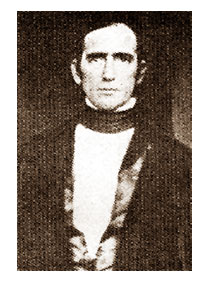
–the house: This was Isaac Williams' ranch house, which Alfred Robinson had visited in mid-1842 and then mentioned in his book Life in California (p. 204): "At the farmhouse of Isaac W– we stopped awhile to rest our horses. It is the most spacious of the kind in the country, and possesses all desirable conveniences."
¶ 188.
– this
cannon: Not many participants in the Californio
battles are still around; but we are fortunate that "this cannon," the Old
Woman's Gun alias El Cónico, is! Franklin G. Mead has
collected information on, and pondered well, the gun, and generously
offers these remarks: The Old Woman's Gun is a quite large swivel gun;
but it is, indeed, a swivel gun (in contradistinction to a field gun).
Description: Bronze, smoothbore, 4 pounder, cannon tube, 43½ inches
overall in length; bore 2.77 inches diameter; 4½ inch muzzle section
length; tube 4 inches in diameter at the muzzle astragal; 16 inch chase
section; 6 inches between 3rd and 2nd reinforce; 9½ inches across at
trunnions. I looked at the vent carefully and found nothing wrong with it.
The "wide" vent referred to by Antonio Maria Osio likely stems from
familiarity with small arms but not cannons. The wide somewhat
lozenge-shaped hole leading to the actual vent serves as a funnel and wind
guard (shield), which minimizes getting powder all over the hot breech of
the gun. The actual vent, the small round hole in the photo, appears to be
in good and serviceable condition. A flintlock musket, rifled musket, or
pistol all have vents, and the pan serves the same purpose as the vent
shield on the cannon, but looks very different. The Old Woman's Gun did
not have any igniting device available and was therefore fired with a lit
cigarette. This clearly indicates that there was no appreciable danger
firing the gun. Caliber-inch: See Botello's Annals, page 258, notes
to ¶ 188 this cannon–"Jose Francisco de Paula
Palomares states that it was bronze and of about six inch caliber." The
Old Woman's Gun was a four pounder with a bore diameter of 2.77 inches and
a length of 41.05 inches, with windage of 0.12 inches, using a lead
cannonball weighing 4.0036016 pounds and 2.65 inches in diameter. The gun
was incorrectly stated by Palomares to be six inch caliber. We know that
the bore diameter was 2.77 inches and not 6 inches. We know that the
cannonball was lead because a cast iron cannonball of 2.65 inches in
diameter would weigh only 2.4641885 pounds. The gun itself probably weighs
about 140 pounds. The socket at the rear of the breech is for a large
round peg used to aim the gun. After being turned over to the U.S. by the
Californios, the Old Woman's Gun was used in battle by U.S. forces
in 1847 and 1848 in Mazatlan etc., as recorded in the engraving on the
piece. It is now in the U.S. Naval Academy Museum at Annapolis, which
kindly supplied the black and white photos which follow. Equally kind was
the permission granted for me to use the color collage of photos below,
which are Copyright 2014 Springfield Arsenal LLC.
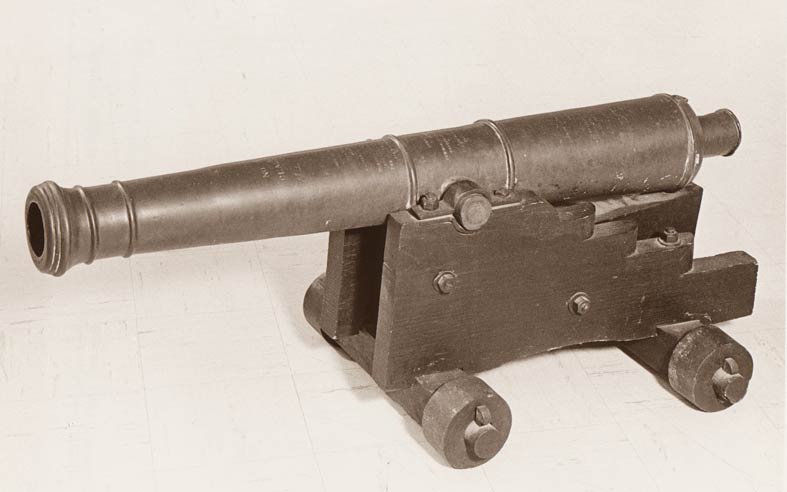

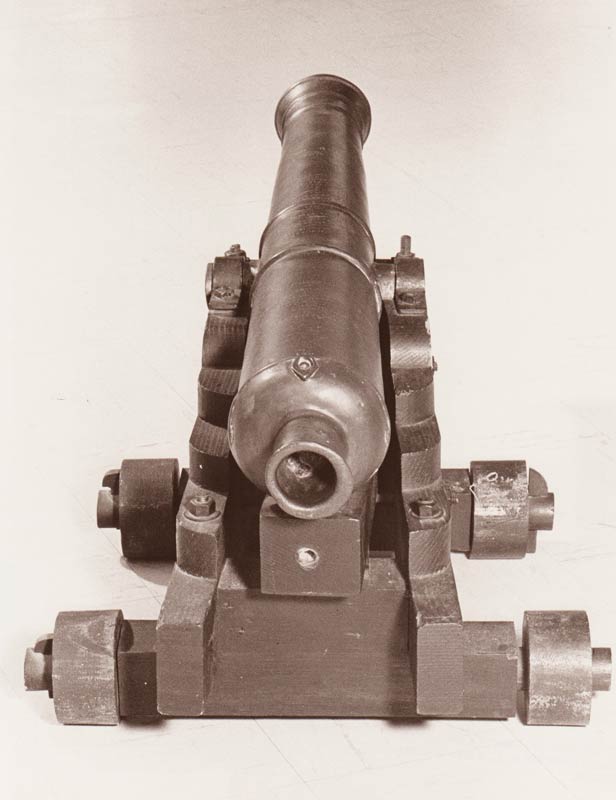
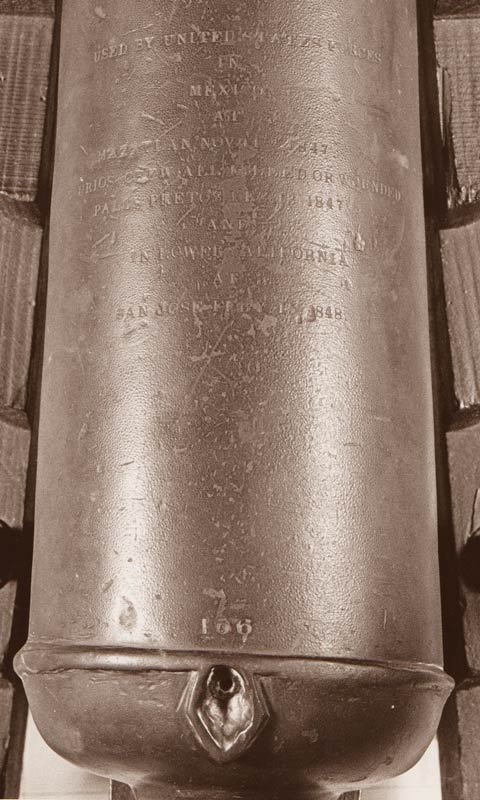
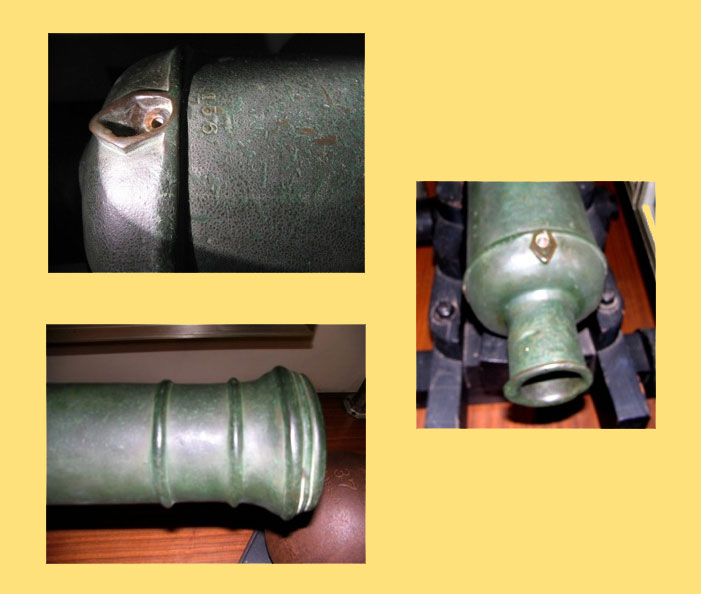
¶ 189.
–Aguilar fired again,
with the same success: Below, a detail from Gunman Meyers'
depiction of the Battle of Dominguez Rancho. He was perhaps not personally
present, as he shows a standard field gun on a standard carriage rather
than the Old Woman's Gun on its modified ox-cart, and shows no presence of
the mustard plants which were so important to the Californios as
providing cover. Civil War historians will perhaps be reminded to some
degree of Miller's Cornfield at Antietam.
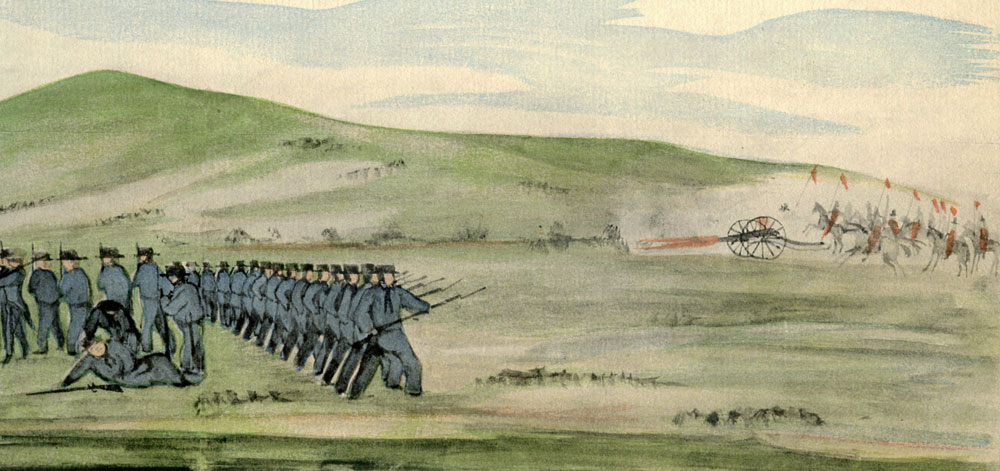
¶ 190.
–"they could some him his
things" should be "they could send him his things".
¶ 194.
–General
remarks: Louis Robidoux, one of the Chino prisoners, makes
some interesting remarks in a letter dated May 1, 1848. Referring to
Flores at this juncture, he writes, "There was at that time a party which
always spied on him, which obstructed his plans and, when it was
necessary, opposed his particular designs. This party, knowing that our
departure was against the general interest of the Californians, and also
fearing a reprisal from the Americans, opposed Flores and formed a plan
(with help from us prisoners, that is to say with our money) to remove him
from office. That occurred on the evening before we were to leave for the
capital [Mexico City]." (This excerpt from article "Louis
Robidoux: Two Letters from California, 1848," in Southern California
Quarterly, Vol. 54, No. 2, Summer 1972.) Who was the spy? I would be
inclined to point in the direction of Jose Antonio Ezequiel Carrillo. If
Flores had the same suspicion, it would go far to explain his attitude
toward Carrillo in this period.
¶ 195.
–General
remarks: As president of the Assembly, Botello was thus next
in the line of succession to be governor, his high-water mark in his
career.
¶ 201.
–a location known as
Los Barrancos: Vischer obliges us with a view.
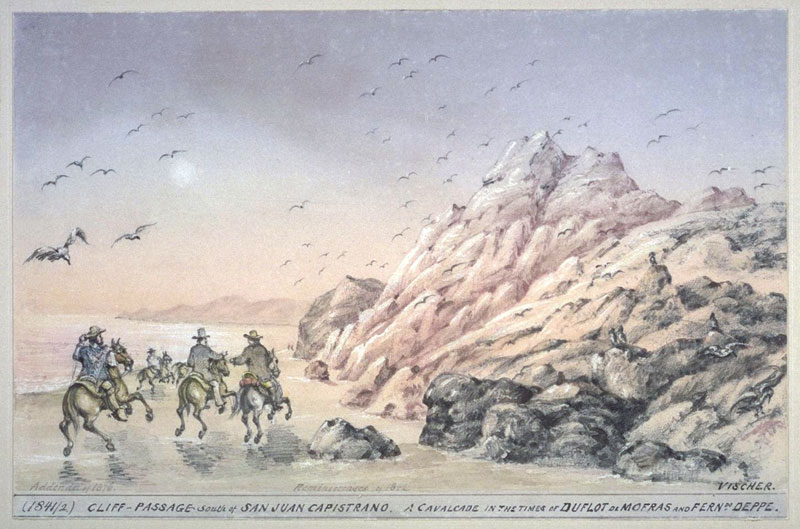
¶ 207.
–The Battle of Bartolo
Pass: The moment of the battle when the Californios
were attacking as the Yankees were crossing the river, Commodore Stockton
directing at center. Sketch of 1847 by Gunner William H. Meyers, much
cropped at top (lots of cloudy sky), acquired with other of Meyers'
sketches by Franklin Delano Roosevelt, and published in the 1939 book
Naval Sketches of the War in California. Diego Sepulveda is about
to call out HALT!, sending the Californios into confusion, and
snatching defeat from the jaws of victory. Juan Avila, in his Notas
Californias for Bancroft, recalls observing this moment of the
battle: "There was a movement [by the Californio forces] which
broke the American phalanx[,] which was in grave danger of
destruction, when Don Diego Sepulveda gave the order to halt to the
Californians who had jumped down to fall upon the Americans. Already
some of the Californians on horseback had broken into the square
[of Americans] and on their return said that the Americans were
taking refuge beneath their carretas" (translation by Lt.
Alfonso Yorba in Orange County History Series Volume Three,
1939). It is interesting to speculate on what would have happened had
Sepulveda not halted the Californios and thrown them into
confusion. Supposing that Stockton had surrendered, as it seems he was
on the point of doing, and the whole Yankee force been taken
prisoner, likely they would have been held as guarantees of acceptable
conditions for the Californios pending the outcome of the war
in Mexico.
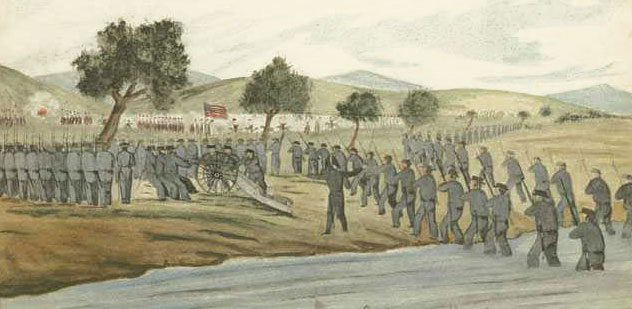
¶ 213.
–The Battle of El
Llano de las Lagunas, alias the Battle of La Mesa: A picture,
slightly cropped, of the battle, by Gunner William H. Meyers, watercolor
of 1847, acquired with other of Meyers' sketches by Franklin Delano
Roosevelt, and published in the 1939 book Naval Sketches of the War in
California. The artist shows rather more carnage than actually
occurred. We're looking from the south; the Pueblo of Los Angeles would be
to the left, across the (unseen) river (the shrubbery at back left perhaps
gives a hint of the riverbed). The eminence at back is the site of today's
Boyle Heights; today, we would see the Santa Ana Freeway curling around
the base of the "mesa."
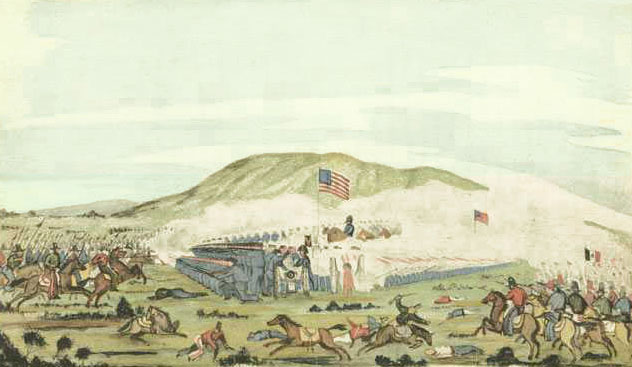
¶ 218.
–"our lives, our
libery" should be "our lives, our liberty".
¶ 224.
–and then go to San
Jose to spend it on bad habits: Referring to ca. 1830, Alfred
Robinson writes, "The town of St. Jose [sic] consists of about one
hundred houses; it has a church, court-house, and jail. [...] The men are
generally indolent, and addicted to many vices, caring little for the
welfare of their children, who, like themselves, grow up unworthy members
of society. Yet, with vice so prevalent amongst the men, the female
portion of the community, it is worthy of remark, do not seem to have felt
its influence, and perhaps there are few places in the world, where, in
proportion to the number of inhabitants, can be found more chastity,
industrious habits, and correct deportment, than among the women of this
place." Ca. 1846, Edwin Bryant writes (in What I Saw in
California), "The buildings of the Pueblo [of San Jose], with few
exceptions, are constructed of adobes, and none of them have even the
smallest pretensions to architectural taste or beauty. The church, which
is situated near the centre of the town, exteriorly resembles a large
Dutch barn. The streets are irregular, every man having erected his house
in a position most convenient to him. [...] During the evening I visited
several public places (bar-rooms), where I saw men and women engaged
promiscuously at the game of monte. Gambling is a universal vice in
California. All classes and both sexes participate in its excitements to
some extent. The games, however, while I was present, were conducted with
great propriety and decorum so far as the native Californians were
concerned. The loud swearing and other turbulent demonstrations generally
proceeded from the unsuccessful foreigners. I could not but observe the
contrast between the two races in this respect. The one bore their losses
with stoical composure and indifference; the other announced each
unsuccessful bet with profane imprecations and maledictions. Excitement
prompted the hazards of the former, avarice the latter." Below, Claudio
Linati's depiction of a group gambling at the game of Monte.
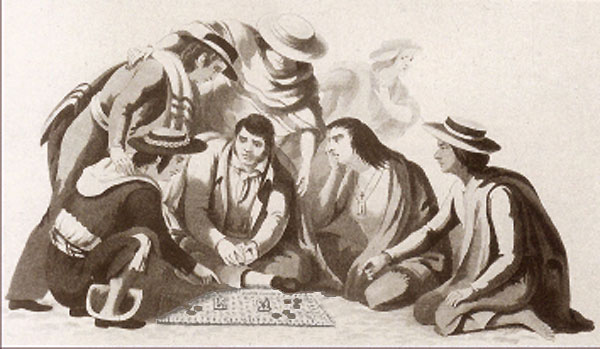
¶ 225.
– I went to San
Francisco to buy goods: Willliam Rich Hutton shows us how San
Francisco "from the hill back" looked in 1847. (Image courtesy the
Huntington Library, San Marino, California, call number HM 43214 (81),
used by permission.)
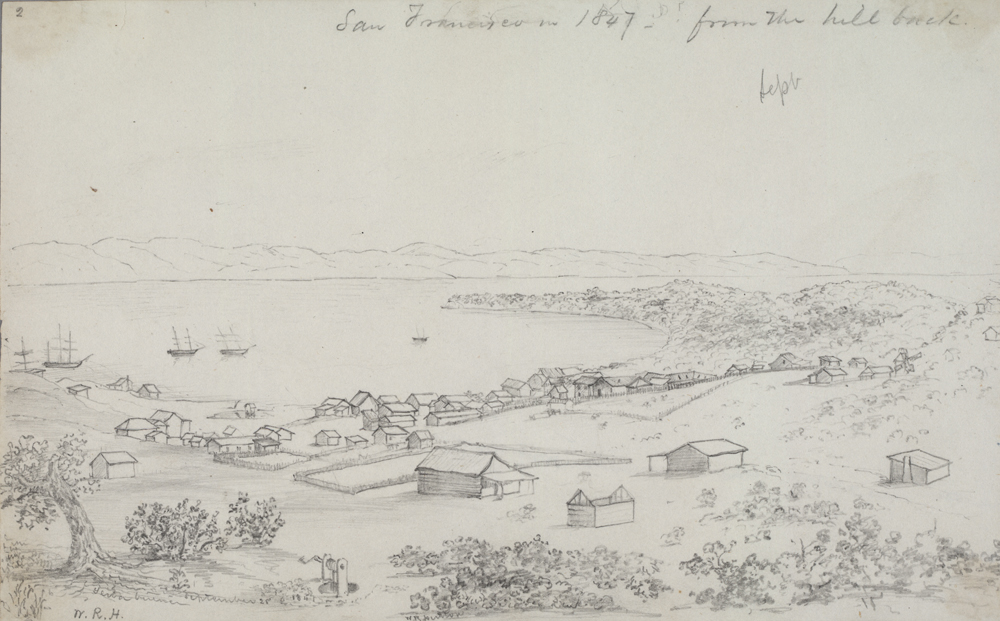
–He advised me to go to Monterey, and board a small vessel: Below, Duhaut-Cilly's view of Monterey, 1827, from the bay. The presidio compound with its chapel can be made out towards the left.

¶ 226.
–and put my people to
work.
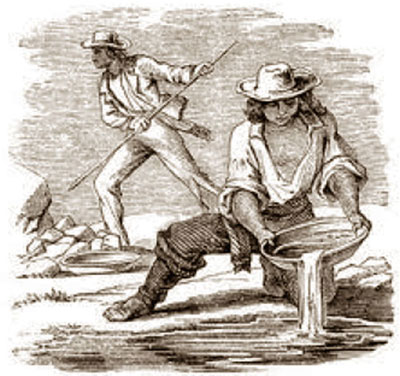
¶ 231.
–"[personal["
should be "[personal]".
¶ 242.
–Juan Domingo, another
German who lived nearby: Below, the home of Juan Domingo, as
it appeared in 1857.
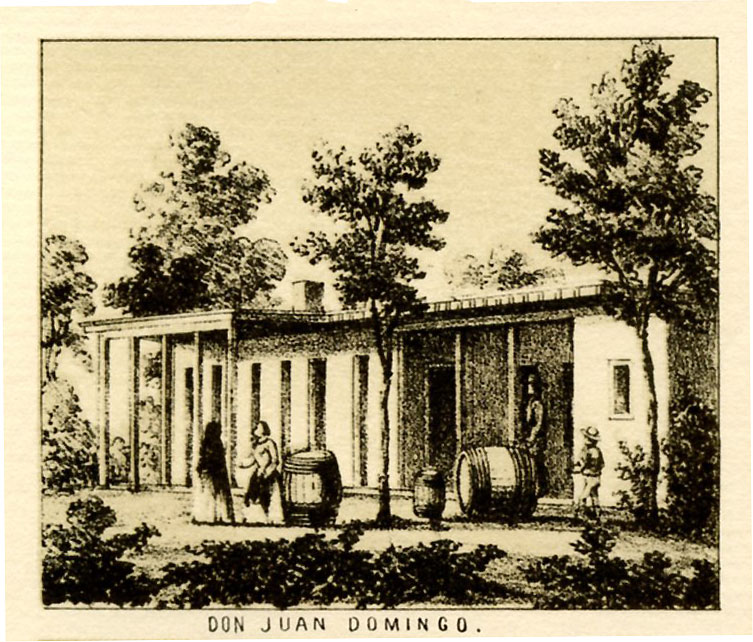
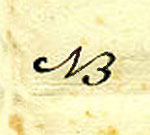
• This section refers to information and/or text in the footnotes:
¶ 1.
–Narciso
Botello: Courtesy the kindness of Narciso's great great
grandnephew Stan Botello, I can offer some new information. Narciso's full
name was Jose Narciso Rafael Guadalupe Botello. He was baptised on
November 3, 1810, in Alamos, Sonora, Mexico. His parents were Vicente
Antonio Botello and Maria Francisca Miranda, listed on the baptismal
paperwork as residing in Minas Nuebas, a mining town about 7 miles west of
Alamos. The sister who is probably the one who went to Los Angeles with
Rafael Guirado was Maria Marcela Rafaela Botello, baptized February 28,
1807. He had another older sister who was named Maria Dolores Sacramento
Rafaela Botello, baptized April 22, 1803, and buried in Alamos June 4,
1838. His younger sister, mentioned in the text as Brigida, was Maria
Brigida Vicenta Botello, baptized October 16, 1821. Narciso's brothers
were Pedro Ysais Botello, who married Maria Concepcion Eligia Ramirez in
L.A. on December 12, 1858, and Jose Refugio Botello, who married Maria
Ygnacia Ramirez in L.A. on October 5, 1884. These two brides were sisters,
and, while not, as wrongly stated in Narciso's obituary, and in other
texts taken from that obituary, the daughters of a General Ramirez,
they were indeed the daughters of Alferez and Lieutenant Jose Maria
Ramirez, who himself appears in Narciso's Annals. Lt. Ramirez was married
to Maria Dolores Palomares, the sister of Ygnacio Maria Palomares (who
finds mention in Narciso's Annals). Narciso's paternal grandparents were
Vicente Miguel Cibiriano Botello and Juana Ysabel Siqueyros; these of
course were also the parents of Narciso's aunt mentioned in the text,
whose full name was Maria Ysabel Ursula Botello. Aunt Ysabel's husband
Jose Guirado (seen also as "Josef") had died April 12, 1819, in
Alamos.
¶ 9.
–latterly kept a
saloon: Rice's saloon was located on the west side of Main
St. between the later sites of the Downey Block and the Lafayette Hotel, nearly directly across from where Commercial St. opened on the east onto Main.
¶ 10.
–Don Antonio
Rocha: At the end of the entry, delete the
"ò".
–entry on the Rectory:
"normaly" should be "normally".
–entry on Antonio
Reyes: Delete the space before "possibly".
¶ 35-36.
–General
remarks: "Padrés" should be "padres"; and "themselves
entitles to promotion" should be "themselves entitled to promotion".
¶ 51.
–entry on playing
cards: "was the the guards" should be "was that the
guards".
¶ 84.
–Vicente
Elizalde: "*Star" should be "Los Angeles Star". Pamela
Filbert, a descendant of Vicente Ferrer Lisalde, very kindly corrects me
that the Vicente Lisalde who married Pilar Blanco in 1859 was not
our Vicente Ferrer Lisalde, and so that sentence may be deleted from
the footnote; and she adds that Vicente Ferrer Lisalde was a member of
L.A.'s first (volunteer) police force under Capt. (and Dr.) Alexander W.
Hope, that he subsequently served as one of the four constables (in 1852),
that he married Minerva Jane See (widow of William Corlew) on September 4,
1888, who filed for divorce exactly a year later, and that Vicente's death
was announced in the Los Angeles Herald on August 4, 1901. Many
thanks to Ms. Filbert for generously sharing this information!
¶ 86.
–We hid ourselves
in the mustard plants: "Lugo, says" should be "Lugo
says,".
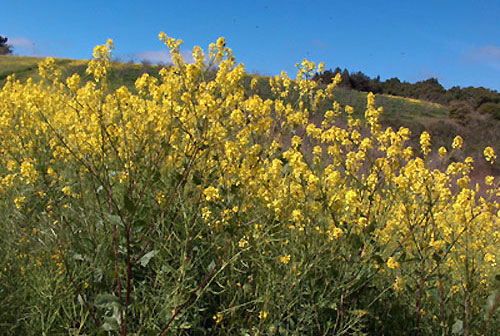
¶ 100.
–Jose M. Ramirez:
I can add to my note about Ramirez in the book that Bancroft
(History 3:16) tells us that, "in a personal quarrel," he killed
the cruel El Capador Vicente Gomez in San Vicente, Baja California,
probably about September, 1827 (more about Gomez in a moment); and in
July, 1828, that he was in San Diego, not making Auguste Duhaut-Cilly very
happy: "Only a few minutes after we had dropped anchor, an officer named
Ramirez appeared on shore and called for us to send a boat; this I sent
manned by four seamen, but they returned without him, reporting that he
insisted on the presence of an officer. Suspecting a misunderstanding, I
myself went on shore and asked him why he had not come in the boat. 'I
judged it not fitting,' said he. 'You should have sent an officer to
receive me.' This pretentious and unreasonable demand set me greatly
against him. 'The boat I sent you,' I responded, and which I have just
come in, should be quite sufficient for the messenger of a government that
does not even have a canoe at its disposal. Such vanity does not please
me; if you have orders to take my declaration [of his cargo] you
may embark with me, but there will be no officer to accompany your return
to land. You now have the privilege of choosing what you should do.'
Seeing how I meant to deal with him, he made some awkward excuses for his
conduct, claiming that he had been badly treated by some other captains.
He finally decided to come on board, and after he had accomplished his
mission I sent him back to shore with no other retinue than the boatmen. I
was all the more uncompromising with this republican, knowing that he
enjoyed a bad reputation, having recently been accused of murder. I was
not displeased to find occasion to show my small respect for him" (from
Duhaut-Cilly's A Voyage to California, the Sandwich Islands, and Around
the World in the Years 1826-1829, pp. 194-195, translated by August
Frugé and Neal Harlow, University of California Press, 1997, 1999).
As to Gomez, the interested reader may revel in the details of his
criminal career in Hardy's Travels in the Interior of Mexico. For
instance, "This wretch was so atrocious in his cruelty, that he spared
neither sex nor age. At that period he had a thousand men under his
directions, all as ferocious as himself. He is still [1826] a
half-pay Colonel in the Mexican army! His station, before his exile, was
chiefly about the Peñou and San Martin, between Puebla and Mexico
[City]. At first he made war only against the old Spaniards; but when
these became scarce, he turned his hand against his own countrymen, by way
of keeping up practice! And there are living instances at Puebla which
attest the success of his skill. He once took a prisoner whom he ordered
to be sewed up in a wet hide, and exposed to the sun, by the heat of which
it soon dried and shrunk, and the wretched victim died in an agony which
cannot be described [etc., etc.]," (p. 122 in Hardy). Gomez spent a
short time in exile in California before his demise at the hands of
Ramirez.
¶ 109.
–Jose Ramon
Carrillo: "(*Star)" should be "(Los Angeles Star)",
and "heredetements" should be "hereditaments".
¶ 112.
–a sentinel by the name
of Higuera: Franklin G. Mead carefully researched the
parentage of Jose Ygnacio Teodoro Higuera, and, citing and supplying much
source material in support, kindly corrects the name of his mother to
Maria Ambrosia Pacheco, who, he writes, "was the mother of Jose Ygnasio
[as spelled on the baptismal record] Higuera. The source of the
error citing Maria Barbara Pacheco as the mother of Jose Ygnacio Higuera
was Mission San Carlos baptism record #2856, 12 November 1812, where Fray
Juan Amoros incorrectly recorded Maria Barbara Pacheco as the spouse of
Jose Antonio Higuera and the mother of Jose Ygnasio Teodoro Higuera. Both
Maria Barbara Pacheco's were already deceased when Jose Ygnasio Higuera
was born. [...]"
¶ 140.
–General
remarks: "dislilke" should be "dislike".
–The wealthy ranch-owners and others: Is this a wealthy ranch-owner (below)? He might be among "others." (From the 1855 Los Mexicanos Pintados por si Mismos.)
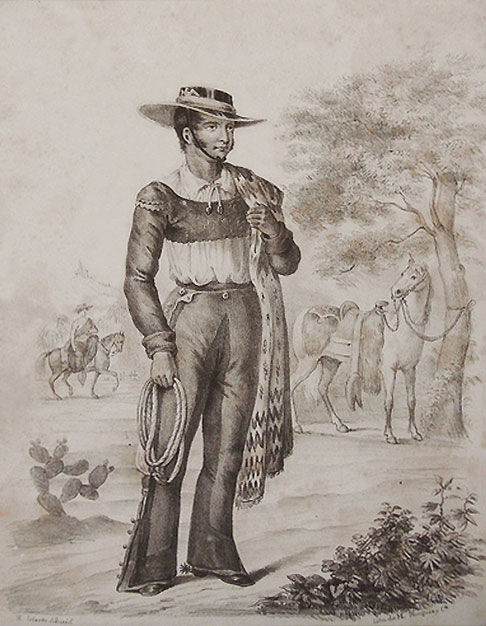
–Francisco Rico: We can narrow the possible date of Rico's wedding to August or September of 1846; and it took place in Los Angeles.
¶ 157.
–Don Antonio Jose
Cot: "far Callao, Peru" should be "for Callao, Peru".
¶ 160.
–sailed for
Mazatlan: Below, Mazatlan in 1847. (Image by William Rich
Hutton, courtesy the Huntington Library, San Marino, California, call
number HM 43214 07 recto, used by permission.)

–to get help from Jean Louis Vignes: Vignes–sometimes called Don Aliso from the great Aliso tree on his property–lived at what would become the Aliso Winery on Aliso Street. Vignes' place had also been where the vigilantes in the Huilo Feliz/La Chala case had met to plan their doings. We see below how the property appeared in 1857, the Aliso tree still going strong.

¶ 163.
–the famous mercury
mine New Almaden: William Rich Hutton provides us with an
image of the New Almaden Mine. (Image courtesy the Huntington Library, San
Marino, California, call number HM 43214 (73), used by permission.)
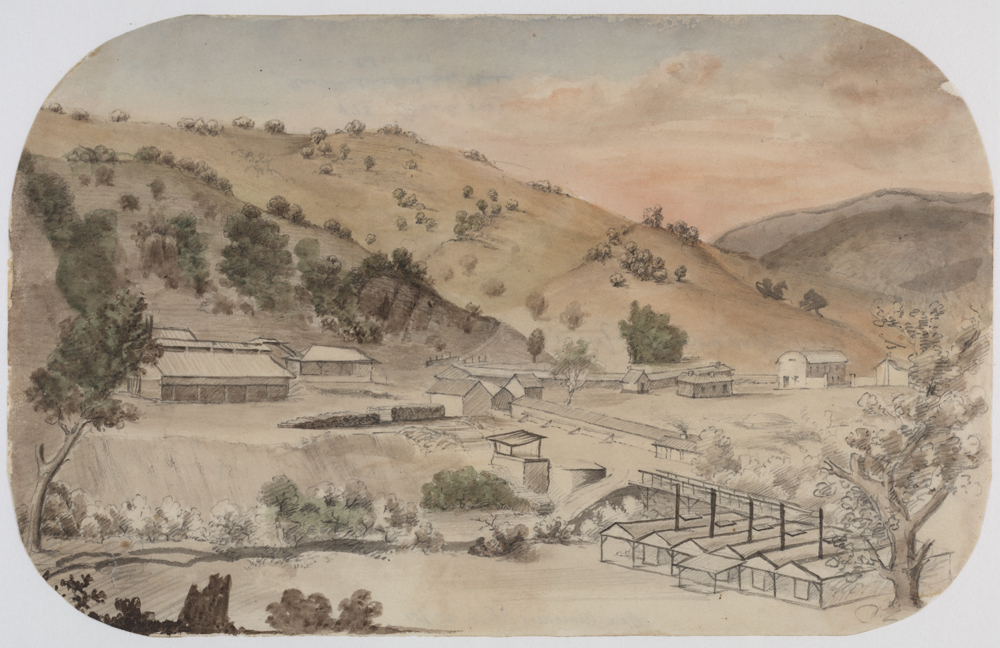
¶ 164.
–showed up in
Monterey: "a grnd dinner" should be "a grand dinner".
¶ 168.
–Eugenio
McNamara: "for a grant of land n California" should be "for a
grant of land in California".
¶ 178.
–The band played a
while: "baggage ammunication" should be "baggage
ammunition"; "later that year" should be followed by a comma.
¶ 183.
–Francisco
Cota: "be in the hands on Gillespie" should be "be in the
hands of Gillespie". Below, we see some of Gillespie, but not his
hands.
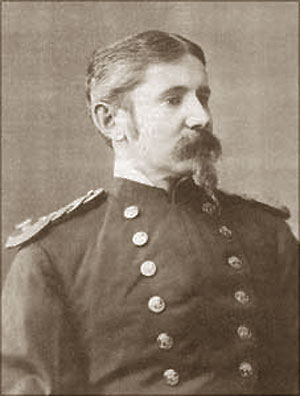
¶ 184.
–the operations and
aftermath of the Temecula Massacre: Below,
Temecula–Vischer's "Temecola"–as he saw it in 1871.
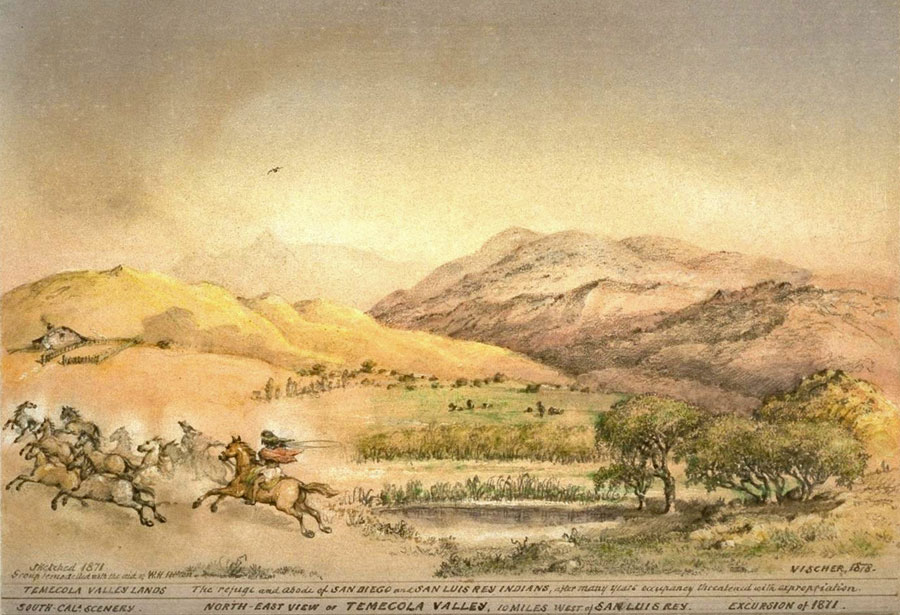
¶ 212.
–the
ponds: "El Llano de la Lagunas" should be "El Llano de las
Lagunas".
¶ 229.
–Don Mariano
Bonilla: "Figueroa that he shold" should be "Figueroa that he
should"; and "he wold say that the funds" should be "he would say that the
funds".
¶ 241.
–or perhaps was expert
at dancing the Jota: Below, the Jota Aragonesa.

Appendix, p. 291: "were holed in the cane" should be "were holes in the cane".
• •
•
We bid goodbye to Narciso Botello and our visit to the Mexican era of California with an image of Mexicano prosperity. El Hacendero y su Mayordomo, by Carl Nebel, 1836. And I bid my patient readers, and the impatient ones too, adios.

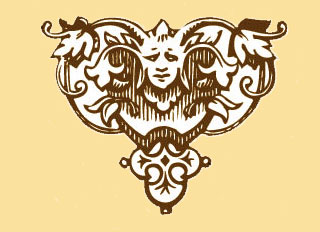
• You may also find interesting information and images at my related site for my book The Bandini Papers. To visit it, click on the image below:
• My other Old California books: